Text
Gxrls Can’t Mix - misogyny and discrimination in the electronic music world
originally appeared online in Romanian for Revista Cutra
A brief note about this translation
I initially wrote this text in July for Romanian intersectional feminist mag CUTRA and they published it mid September. The focus was supposed to be on events that did take place locally, however, this summer there’s been a constant stream of tweets from female-identified and enby djs/producers about their horrendous Boiler Room experiences.
I wanted to shine a light on that and the endemic kind of sexism that boiler room is constantly facilitating and refuses to take any responsibility towards, as well as share some of the horrors from the Romania scene that nobody wants to talk about because we still live in a very homophobic, racist and sexist environment. As a local queer artist myself, I do believe it is our duty to speak up on these issues even if it may negatively affect our social/professional life. The local community leaders do know what they need to do in order to create safer, more inclusive spaces yet prefer to use a superficially woke discourse that looks good online, yet they would never take direct action or present an unpopular opinion.
Having spoken to Ceci after their Boiler Room and their scary bad experience (including receiving multiple death threats), it became increasingly clear that this text needed to exist in the world. Also running into Lakuti last week in Berlin and hearing how traumatized she still is after her experience playing in Romania, I was all the more motivated to translate it into English and make this available for everyone.
It may be sprawling at times, but I think it’s important to present a translation of the original published material, as it appears on the CUTRA website. Please keep in mind that CUTRA is not a music/dj-specific publication so certain aspects of the industry come with very ELI5 explanations.

First I thought she was just messing with us, but now i m starting to think that this girl doesn’t know what she’s doing
This is boring room not boiler room
Are they trying to put us to bed and broadcasting Schumann resonances?
She would have been better at spinning pizzas than records
Go back to the kitchen!
These are just a select few from the over 2000 comments of the very first Boiler Room live stream taking place in Romania. Said comments appeared on the initial Facebook live post. The event took place in July 2016. At the time of writing this article [na – july 2019], all the comments are still publicly visible on their page.
I could probably write a thesis on misogyny in electronic music, but for this particular piece I’d like to focus on the following question: why do we saying that gxrls can’t mix?
I would also like to ask the follow up questions: should we be surprised that colleagues from the Romanian club industry would say that a female-identified person is a sick DJ but „a little too homely” to play a certain club? Or that another person I used to consider a close friend would tell me during a b2b set that because he just took some MDMA I looked like „a juicy piece of meat” to him? Or how when Electronic Beats Romania did their first feature on local producer Admina and they didn’t even know who to contact from the magazine to moderate the deluge of hateful comments? Or how nobody even bats an eye at the way industry men here always tend to grab you by the lower waist when talking to you in the club as if it were the most natural thing in the world? Try to explicitly say something and you would be instantly labelled an „unchill bitch”.
The answer is a resounding yes. We should be surprised, as well as angry and concerned enough to start actively doing something about this.
Miss I’s Boiler Room

On July 6th, 2016, the promoters behind the Interval event and festival series put together the very first Boiler Room in Romania. For those of you less familiar with the club world, Boiler Room is a platform that organizes events specifically designed to broadcast a live video stream of the club experience. Think DJs mixing or musicians doing live sets, while also making a point in filming the audience and their reactions to the music. Since its inception in 2010, Boiler Room has become a global phenomenon, with immense pull in the industry. The project is equally revered and reviled to the point that there are parody YouTube channels (see People of Boiler Room). For most artists, being on Boiler Room is a make or break moment, sort of like a calling card highlighting your skill as a DJ.
Promoters, fellow DJs, agents and ravers all follow Boiler Room religiously. The platform’s increased popularity and growing volume of videos produced per week may have slightly decreased its influence due to sheer oversaturation, being on BR is still the highlight of many up-and-coming artists’ career. Unlike a mix, the BR videos don’t just physically show off your mixing skills, but they also document the audience’s reaction in real time. Oh, and as a DJ you only get 60 minutes to give it your best. Or, as with Miss I in the following example, you’ve just been asked to open the very first BR broadcast ever from your country. Miss I is one of the most beloved local female DJs, also responsible for opening the first vinyl only record store in Romania and highly appreciated in the minimal/deep house scene, so you know there’s gonna be eyeballs. But no pressure, u do u grrrrl.
For every Boiler Room event, the broadcast is livestreaming on their website and Facebook page. Reading the live reactions on the chatroom and Facebook comments is intricately related to the experience. On that humid summer afternoon in a rooftop garden in Rahova, the comments that started pouring just a few minutes into her set were absolutely shocking. The level and volume of vitriol had greatly surpassed the BR staff’s expectations. About 40 minutes in, the host publicly posted a call out comment.
However, while researching this article, I was surprised to discover that most of said harmful and sexist comments were still up online. There were no attempts on behalf of the BR team to warn or ban users. Hell, there was no moderation. But maybe there should have been.
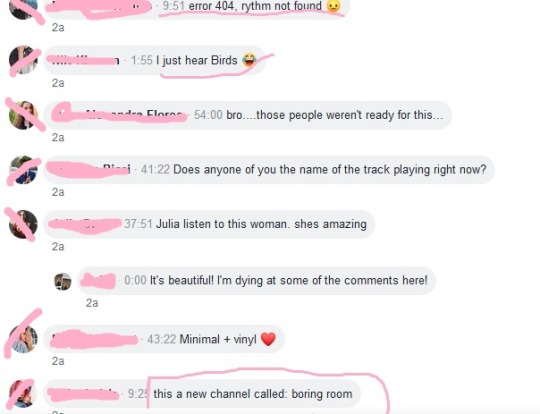
The Boiler Room Effect

Part I - San Francisco Pride, 2019
This story took place in 2016. We could easily justify what had happened by claiming we don’t like to talk about gender politics at the club or how, generally speaking, the Eurominimal/tech-house scene the event was catering to is notoriously populated by aggro cishet bros who worship Villalobos. Unfortunately (surprise surprise!), this has not been the first, nor the last online scandal Boiler Room has been responsible for.
During the writing process for this material, initially meant to focus mainly on Romanian issues, I started paying attention to the comments on recent BR livestreams. This process, coupled with the increased number of artist friends talking about the backlash in the comments following their BR streams I was seeing on Twitter lead me to believe in the dire necessity of live moderators for the entire BR social media. These comments are not just mean spirited or unfunny trolling, they can be incredibly harmful and have a lasting negative effect.
On June 1st 2019, Boiler Room organized a Pride-related event in San Francisco where an artist I not only appreciate but happen to occasionally work with made their debut. Ceci aka CCL is a DJ, producer, co-founder of queer collective TUF and [at the time of publishing] agent working for Discwoman, an NYC-based talent agency created to boost womxn and non-binary artists. CCL identifies as non-binary and uses only they/them pronouns. Being AFAB and feminine presenting, they are often misgendered due to their presentation, even after clearly stating their preferences.

In the beginning of the video, the host does use their correct pronouns, but most people in the comments were still referring to them by using she/her pronouns. This might seem like a minor inconvenience compared to the bulk of the discourse happening below the stream, mostly comprised of people complaining about the music, ranging from how weird the selection is, whether or not that sound is a faulty cable and how bad their technical skills were. Later Ceci confessed they even received actual death threats. All this was happening at a Pride-related event in one of the gayest cities in the world and with a line-up specifically tailored for the occasion.
Being misgendered is always a bad experience, but when it happens during what is supposed to be a career-defining moment, the effect is even more traumatic. Besides, a torrent of sexist and negative comments cannot have a positive effect on anyone, regardless of their gender or sexual identity. Especially with BR, this only seems to happen when female-identified or non-binary artists are concerned. In CCL’s case, the misgendering may have not been the most atrocious part of the online response, however we do need to start implementing such habits as not assuming one’s gender or choice of pronouns. It may seem like a small step, but it does make a world of difference.
What Boiler Room continuously refuse to do is acknowledge the influence it carries in the industry and the responsibility that comes with that. BR could have avoided causing a lot of damage by simply adding a little blurb about the artist’s preferred pronouns in the description of the Facebook live video, for the users tuning in later or not familiar with their work.
It’s this kind of thoughtfulness and concern for the actual scenes they feature that is consistently lacking from their approach.
Part II - The Sherelle Incident
In March 2019, a different incident took over both the online and offline music discourse – for approximately two whole weeks, all you could see on Techno Twitter were reactions to Sherelle’s Boiler Room. In short, there was clip of a POC female-identified DJ from the UK playing bass and jungle to a packed room going totally berserk until someone from the audience touches the CDJs and the music stops. This unwanted intervention coming from an unidentified hand created a meme-worthy WTF reaction. To nobody’s surprise, this snipped was the one Boiler Room chose to use as their preview advertising her set online. All of a sudden, her startled face in the clip was all anyone could think of, not the incredible atmosphere she created. Yewande Adeniran wrote a thoughtful piece on the implications and how said “accident” took the discourse away from a moment that was supposed to be just about Sherelle and her skills as a DJ.
Following the incident, the Twitter community managed to ID the person who caused the hubbub, who turned out to be infamous UK DJ Riz la Teef, who was also playing the event. Online, he’s been bombarded with accusations of racism and misogyny to the point of having to delete his account. However, a wave of reputed DJs and producers jumped to his defense and justified his action. Keeping in mind that most of what we call Techno Twitter is comprised of people from/who live in North American, their argument was that his unwarranted intrusion was in fact a very common practice from the UK grime/bass culture.
Known as a wheel up or to turn up, it consists on moving the jog (the little CDJ wheelie thingie) to rewind the track playing and increase the hype. It’s traditionally considered a sign of appreciation and supposed to be very flattering when your friends/fellow DJs perform it. Think of it as a hands-on rewind. Only in this case his attempt failed and the only thing he managed to accomplish was create a whole lot of confusion. Plus, they were friends and earlier in the clip you can see him come say hi and hug her. In true Internet fashion, think pieces from major publications followed, educating the poor American kids on the wheel up, as well as photos with the two hugging and making peace, telling everyone it’s time to chill out. As for Sherelle’s part, I’m actually curious what else was she supposed to do than say something along the lines of “OK, fine, let’s move on”? It’s already hard enough to break through in the industry as a queer black woman, the last thing you want to do is be that unchill bitch who can’t take a joke.
Our Daily Misogyny
Going back the shitty things that happened in Romania chapter, I want to talk about an incident that happened in October 2016 at a Queer Night party in Guesthouse. To give you a little context, Queer Night is a series of queer parties, the first of its kind, co-run by local choreographer/dancer Paul Dunca and DJ/singer Cosima von Bulowe for over a decade. Guesthouse is a club mainly associated with the Rominimal/tech-house cult, with a pretty cishet, homophobic audience. However, they occasionally host the odd underground event, like DJ Stingray or Lena Willikens. This particular event was a collaborative effort between Queer Night and the Interval (the people responsible for the Romanian Boiler Rooms – na) curatorial teams, who invited queer womxn DJ couple Lakuti and Tama Sumo to do an extended back to back set. Lerato Khathi aka Lakuti is an incredibly talented DJ from South Africa, who also runs the label and talent agency Uzuri and Tama Sumo has an extensive DJ career and also books for Panoramabar.
As Lerato was mixing, a guy standing in front of the booth reaches towards the turntables and touches the record that was playing and the music glitches. Lerato simply froze for a second but continues to carry on mixing. A few minutes later, said guy suddenly appears behind the booth (access to the booth and the backstage area requires a separate bracelet) and tries to get her attention and starts touching her. In that moment, Tama rushes in and extracts the person from the booth. In spite of his highly inappropriate conduct at event that promotes safe spaces, the security staff refused to kick him out of the club for a fuzzy array of reasons – friends with the owner, being a “house regulars” and my favorite “he didn’t beat up anyone” line. Considering the organizers’ credo and position as community leaders, they could have done more than simply trying to minimize the incident.
The rest of the night went well and their set was lovely, but talking to them the next morning, the entire experience didn’t sound like just a minor incident of a someone being an asshole: Lerato confessed that even though she traveled and played all across the globe, she’s never experienced anything remotely similar.
I’d love to be able to say that these stories are just rare occurrences. Unfortunately, being in the music industry reflects a much more grim reality of endemic sexism. Let me suggest a little exercise – take for example any Boiler Room video on Youtube where there are female-identified performers and within the first dozen comments you might something along the lines of “she can’t mix”, “great selection but her technique is lacking” or “X guy did this so much better in the ‘90s”.
Perhaps we all know by now that commenting on a womxn’s appearance is a no-no. Yet I still constantly hear various industry men making comments that womxn like Peggy Gou or Jayda G only got where they are now just because they’re hot. (How come nobody calls out Marcel Dettman for looking like a model I ask you?). Unlike jabs at someone’s looks which are easy to dismiss as harmful, commenting on someone’s “skill” and “technique” are seemly OK because they refer to an objective (they say) variable, easy to judge and quantify. I ask you this – doesn’t this all sound terribly familiar? Perhaps using the same arguments as those right wing Youtube personalities that post videos with titles such as „X DESTROYS feminists with FACTS and LOGIC”?
Consequences of the systemic sexism are starting to pop up everywhere, from Resident Advisor closing down their comments section due to the amount of harassment related to their recent focus on female artists to the petition against Giegling’s Konstantin. For a quick reminder, German DJ Konstantin used a bunch of “biological determinism” arguments in an interview trying to explain why he believes women don’t have the right kind of brain for mixing. In 2018, Konstantin was booked to perform at three major parties during Amsterdam Dance Event (ADE), a key annual gathering for the electronic music industry. A petition signed by thousands of fellow DJs, music journalists and electronic music artists circulated online to have him blackballed due to his comments and half-assed apology that followed. Unfortunately, the only result was the ADE organizers offering him even more exposure by inviting him to talk about his actions on a live panel.
This kind of discourse is very dangerous, as by accepting and normalizing it we’re offering it unwarranted legitimacy to the point that opinions such as Konstantin’s start being reiterated by the press. After this year’s Movement festival in Detroit (the birthplace of techno), a journalist in a local newspaper writing a piece on the women’s rising visibility in electronic music, cited a “veteran DJ” who claimed women lack the technical capabilities to mix and rely on laptops and software in order to do their job. Despite this not being the author’s argument, he chose to offer a platform to a blatantly misogynistic opinion. These positions are not just wrong and should be called out for their obvious sexism, but perpetuating them in the press further increases their destructive power. The more we will continue to validate them, the more present they will become.
And still, why do we keep saying gxrls can’t mix?
Are girls really all lacking in the rhythm department? Commenting on one’s ability to mix is still one of the most widespread forms of criticism that AFAB and female-identified persons get. Why is it so widespread?
Through mixing, the art that defines the modern dance music DJ, most people understand creating a story through a continuous body of variegated music but particularly having no pause between the tracks. When industry people talk about mixing, they usually refer to beatmatching, which is usually means blending two or more tracks, often of different tempos or keys. The overall tempo of the DJ’s mix can remain constant or experience subtle increases across their set. This style of mixing, using long transitions, no tempo changes and working within the same musical subgenre throughout is particularly appreciated in Eurominimal and tech-house, which is also the most lucrative part of the industry in places like France, Germany and Romania. As many talented DJs have proven over the years, from legends like Larry Lavan or David Mancuso and their cosmic or loft deeply personal, eclectic styles, the perfect blends same tempo school is by no means the only “right” way to think about a dancefloor.
At a time when dance music has exploded into a multi-billion dollar industry, the “perfect mix” paradigm became the dominant style. In this climate, to be a DJ is synonymous with knowing how to mix, otherwise you don’t exist. Or at least that’s the androcentric perspective. And once you frame things like this, the comments on womxn’s “technical skills” stem from the same sexist pool as saying womxn are not good at math/science/driving or other “men’s” activities. After all, they’re just being objective, right? “Oh my god it’s not like I said she was fat or something!”
Mixing is a learned skill that requires practice to be perfected. The portion of the population who is encouraged to learn skills that involve music and technology, who is not discriminated against and has access to often costly equipment (be it controllers, CDJs or turntables) is overwhelmingly cis, straight and male. I can’t tell you how many times I’ve heard the “I don’t have a mix online/nowhere to practice because my ex bf had all the equipment” story. Or gxrls saying they never learned how to mix because they didn’t have access to equipment. Or the supportive “nice guy” story who invites you over to “teach you how to mix” but quickly loses his interest once you reject his sexual advances.
It’s refreshing to see groups like Room 4 Resistance, No Shade or Discwoman not only organizing events, but also putting together free mixing workshops for womxn and non-binary people. People are also trying to change things in Romania, with groups like Corp. or Queer Night trying to tilt the gender imbalance locally, only unfortunately their efforts are lacking the infrastructure, institutional support and ideological consistency.
Where to Now?
We’re in 2019. DJs like The Black Madona, Josey Rebelle or Octo Octa and Eris Drew are some of the most in-demand people in the circuit. They all approach the dancefloor differently and bring unique views of what a DJ set can be. Yet straight white boys are feeling threatened by their success and are constantly looking for arguments to delegitimize their success. “Yeah, but this person is getting booked everywhere just because it’s cool to be trans now” – as if anyone would go through the intense process of forever altering your body just because queer is “in”! “Oh if I had tits I would get more gigs” – another male DJ I used to call a friend told me when I started playing more in Bucharest. I’ve heard phrases like “but why do women only book other women?” or “how can the super talented boys ever breakthrough in this environment if women are getting all the attention?” more times than I can recount.
Straight white boys need to shut the fuck up! For decades, the vast majority of people in charge of running/booking clubs were straight white men who would only book other straight white men. Yes, there we certainly do see more womxn in line ups, but just as female:pressure cares to remind us periodically, the percentage is still predominantly male. The healthiest path towards building a more diverse and inclusive music world is not having the old gatekeepers trying to educate themselves and perform acts of tokenism, but make space for marginalized people in decision-making positions, because nobody could make more informed, coherent and inspired choices than a person who is deeply involved in the community. Just see Discwoman’s Frankie miracle work over at Bossa Nova Civic in NYC. And it is very likely that with the right people running the show, incidents of abuse and harassment will diminish as well.
Womxn have been so used to be touched without consent and constantly harassed that we’ve been programmed to dismiss such indiscretions as minor inconveniences, something that “comes with the territory”. In order to see an improvement of this state of affairs we have to become more radical in our attitudes against sexism and discrimination. We absolutely need to learn to speak up whenever we encounter misogyny, racism, homo and transphobia and, most importantly, believe womxn when they come forward with a story of abuse of boundaries crossing because whenever we brush it off with things like “he was drunk”, “it was just a joke” or “there are two sides to every story”, we become complicit and contribute to this toxic culture.
The good news is that we can all contribute to changing things. And no, you don’t have to go to a march or join an organization if you want to help out. Change starts in your own immediate community by simply calling out your friends when they say something sexist, not supporting the known abusers and problematic people in the industry and just coming out to see one of the local womxn artists.
We will continue to play, to defend the DJ booth as sometimes the only safe space we might have at the club, to record our music however we can and become ten times better than all male DJs who told us we don’t know, we can’t or we “don’t have the necessary biological conformation”. But, most importantly, we’ll keep making people dance.
images, in order of appearance
queer night at apollo 111, 2017
miss i boiler room, 2016
edited screengrab from comments in the miss i boiler room facebook stream
crowd at miss i boiler room, 2016
ccl at rewire, 2019
all photos courtesy of the author
0 notes
Text
Poemproducer
comissioned artist bio for AGF
German artist AGF aka Antye Greie-Ripatti is a sonic warrior and electronic music producer. Her music inhabits an augmented space where pounding experimental techno, spoken word, abstract video art, feminism and radical ecology create a self-sustaining environment. Originally from East Berlin, she started to develop a DIY approach early on, while also using her voice to fight against oppression by supporting marginalized communities and calling out injustice, most recently through female:pressure, a support community and promotional platform for female-identified electronic musicians. Currently based in Northern Finland, Antye founded the local arts organization Hai Art in Hailuoto. Since its inception in 2011, Hai Art has been involved in numerous sound-related projects, focusing on media arts with children. Antye acts as its director, curator and a workshop instructor. Active since the early 90's, she has collaborated with strong names in electronic music such as French pioneer Eliane Radigue, German legends Gudrun Gut and Ellen Allien, British avantgardist Kaffe Matthews, Finnish IDM treasure Vladislav Delay and classical composer Craig Armstrong. Antye Greie-Ripatti, better known as AGF, uses electronic music as her medium to express her love for poetry, nature, new media art and strong female figures. A self-described poem producer, she courageously walks the thin line between music, contemporary art and activism. Antye (or Agee, as friends call her) grew up in East Germany and witnessed firsthand the fall of the Wall and the rise of techno culture. As a teen, she directly experienced the crumbling of dictatorship and took Philosophy courses at Bauhaus Dessau, which lead to her questioning her Marxist upbringing. In the German macho white hetero techno scene of the early 90's, men were banishing vocals from the club, insisting on not expressing emotion. Antye, on the other hand, rebelled against the trend by incorporating spoken word and poetry within her rough, techno sound. Her curious nature and mercurial spirit allowed her music to expand beyond the confines of traditional beat making, into the realm of sound art, poetry, video, performance and activism. Twenty years, some awards and collaborations later, she is still fighting to get women the visibility they deserve, whether with online platform female:pressure or by collaborating with risk-taking artists such as Afghan refugee Kubra Khademi. Active for over 15 years, female:pressureis for electronic music what Guerilla Girls was for contemporary art. Their charts breaking down the glaring inequality of male and female artists in music festivals have reached internet art status. Antye lives on an island in Northern Finland, records sounds in the woods, posts poems via twitter and through a poem newsletter one can subscribe on her website. In 2011 she founded the arts organization Hai Art in Hailuoto, where she activates as director, executive producer , workshop leader and independent sound curator. Over the years, Hai Art has organized numerous conferences and art residencies, mainly focusing on programs dedicated to children. They developed projects such as the iPad Orchestra Hailuoto, built an acoustic sculpture The Hailuoto Organum in public space, facilitated a children MediaLAB and numerous sound art camps. Her work is constantly expanding into new territories, most recently incorporating radical mycology, performance art and radio work.
0 notes
Text
Phil Minton - The Untamed Voice

Phil Minton is no regular artist - the revered improviser has a spectacular career spanning over four decades, whose collaborations include Audrey Chen, Tom Cora, Radu Malfatti and Mike Westbrook and a vocal improv quintet, Five Men Who Sing, with Jaap Blonk, Paul Dutton, Koichi Makigami and David Moss.
While deeply rooted in his solo practice, Feral Choir is a unique approach to improv, stripping down the concept to the very bare elements of the human voice, beyond language and music.
Dubbed as “an improvisation workshop for everyone who ever wanted to sing but was afraid to”, Feral Choir invites amateurs, professionals and shower singers to step out and rediscover their voices.
During the 20 years of doing the workshop, Phil had groups ranging from 10 to 60 people, including actors, improvisers, fans, children and even mentally challenged participants. Its nature transcends language and cultural barriers, offering a raw, primal communication system.
Participating in the workshop is a highly entertaining, often transformative experience. Under Phil’s direction, people blend humming, whistling, shushing and other bodily noises into a wild, cacophonous symphony.
In anticipation of the Feral Choir workshop at ODD, Phil was kind enough to answer a few questions about the project.
Andra Chitimus: I know you get asked this a lot, but I wanted to know how did the Feral Choir idea originate, especially in relation to your solo work. It is quite brilliant how you managed to strip down vocal improv to the essence and create this incredibly inclusive performance.
Phil Minton : I was asked to do a solo in Sweden, but as is often the case, its conveniently helpful with funding to combine performances with ‘reach out" projects that involve a community. So I had no initial big idea for the feral choir, the choir helped fund my solo or group gigs and i was very reluctant at first to accept offers. I had no teaching experience and i found It difficult to tell people what to do. This all changed one day when a partner of one of the choir singers told me ‘I have never seen her so happy’.
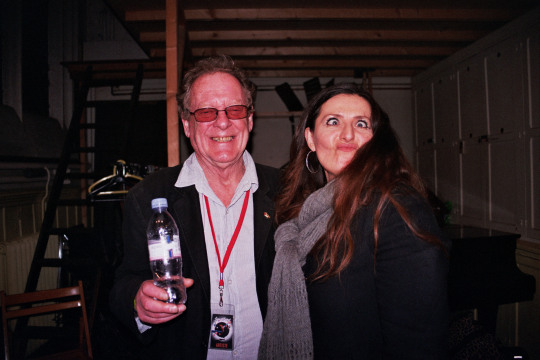
AC : You’ve been doing the choir for almost 20 years now; what have you learned from the experience over the years?
PM : That I love the sound of people breathing, bubbling, whooping, laughing and singing many more wonderful sounds together. I’ve heard some the best music that I have ever heard on many of the feral choir concerts.
AC: Do you believe participants in the last few years are more open to the experience?
PM: Yes, but that does not mean the worlds a better place.
AC: When we met in Paris you told us this story of the muslim women who came to the workshop as part of a cultural integration program and didnt really know what to expect. I remembered you said you were having a hard time getting through to them, but once you showed them the rocking the baby/lullaby sign they immediately understood and opened up. Do you believe the workshop is a way to transcend language barriers?
PM: Most humans love singing. Fuck the words.
AC: What is your most memorable/favorite moment from the workshop?
PM: Being told after a performance that someone had called the police from outside the venue, they thought there was a Riot going on inside. The police had arrived but took no action because they could not 'understand’ what was happening.
AC: You’ve had countless collaborations over the years, recently with young improvisers. Is there anyone in particular you would like to work with and haven’t had the chance yet?
PM:The trumpet player Peter Evans.
AC: This will be your first time in Bucharest; its musical heritage ranges from the work of spectralist composers like Iancu Dumitrescu/Anamaria Avram to gipsy manele music and wild electronic explorations. Do you think this background will influence your approach to the workshop?
PM: I’ve done workshops all over the world, in prisons, with homeless people, with composers and drunks, with autistic and Down syndrome singers, scientists, opera singers, rappers and plumbers and with anyone who’s wanted to be part of it. So I try not to adjust initially to the multitude of cultural backgrounds that any group could have. But as the workshop progresses I hopefully integrate all these in performance. Like the man who told me he did not understand what to do when asked to join some free vocal improvising. He loved singing, but could only sing parts of Ukrainian pop songs that he could remember, all cool, he was wonderful.
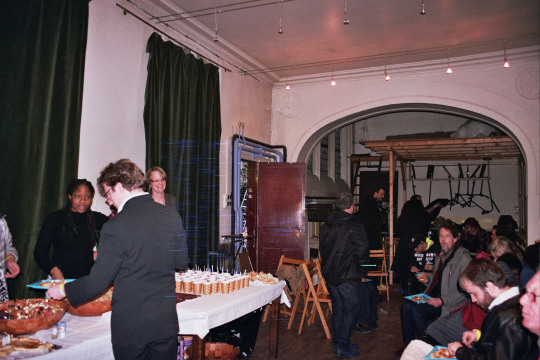
AC: In Paris you used to punctuate the rehearsal breaks with yodeling; Romanians are also mountain people - do you plan to teach us to yodel?
PM: I use yodelling as a vocal exercise to relax my voice. I can give some tips and point in the right direction to those who want to yodel but find it difficult. Looking forward to hearing some Romanian mountain yodel.
AC: And, lastly, since I have participated in the choir, I know how much fun it can be but Romanians can be quite shy when it comes to participatory practices. What would you tell someone who is still on the fence about joining?
PM; Many people who come to the workshops do not make a sound for maybe an hour, but I know they are loving it and they do join in eventually. One in a thousand who come leave after the first 10 mins??… I just thought, maybe they are all cops or soldiers and don’t understand.
AC: Thank you Phil!
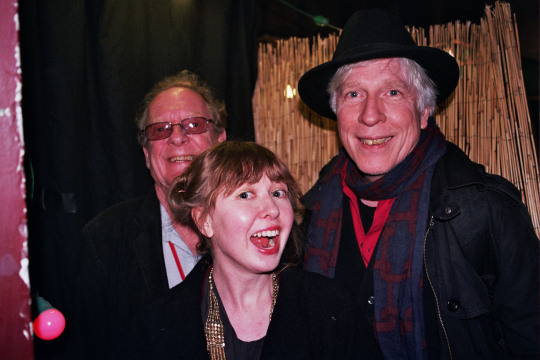
The workshop takes place July 10th-12th, with rehearsals Monday and Tuesday, followed by a performance on Wednesday. Please sign up at [email protected]
0 notes
Text
A CAT scan of the Contemporary Subconscious
for The Attic Magazine

Potentially Everything
In recent years it seems that festivals have become the dominant musical events. While it would be rather pointless to add to the debate about the extraordinary surge in festivals, traveling to more and more events and seeing the similarities in tone and programming, one cannot help but wonder – what makes a festival special?
Rewire is a discreet but dense affair in the experimental/dance music hybrid in The Hague, not a very obvious choice when it comes to the Netherlands. The picture-perfect surroundings and walking-friendly size of the city made for a very pleasant festival destination.
While Rewire could be compared to the Unsound/CTM family, it is not an overtly music and contemporary arts festival, nor is part of the SHAPE network, carving a more distinct path. Despite not having an overall theme, subjects such as activism, feminism, nostalgia and emotion in music ran like a red thread through the programming. Adam Harper’s excellent essay The Music of the Body, published in the festival booklet was a very helpful starting point in this respect.
Rewire is certainly a place for discovery: featuring 45 min live sets and having the venues at about 5-10 minutes walking distance from one another with the schedule slightly overlapping, one could potentially experience a significant dose of every act.
This system worked pretty well between the Paard and Prins 27 venues across the street from each other, but going any further one felt the need for a bike, as AGF confessed to literally “running like a child” after her talk, in a failed attempt to catch Pharmakon’s set.
Regardless of those glitches, the three days were perhaps my most action-packed musical vacation.

Tulip Fields, Feminism and Improv
After spending a couple of days in Amsterdam, I took a rideshare to Den Haag, rushing through the flat fields populated with the occasional cattle and monochrome strips of tulips. Armed with my press bracelet, the city was starting to morph into the magical festival bubble as I ran into my friend Max and the rest of the Horse Lords on my way to the Korzo Theater.
Missing the Forest Swords talk right on the nose, I spent some time in the festival-dedicated-area of the lobby and putting together my plan for the evening.
As the doors finally opened, I was really happy to see my long lost festival sister Amy, a happy coincidence creating a shift in my usual festival narratives, resulting in a more gynocentric experience. Together with her colleague Holly, our new female-journalist-power-group was born. It was the perfect setting for exchanging impressions and making those though choices between conflicting acts.
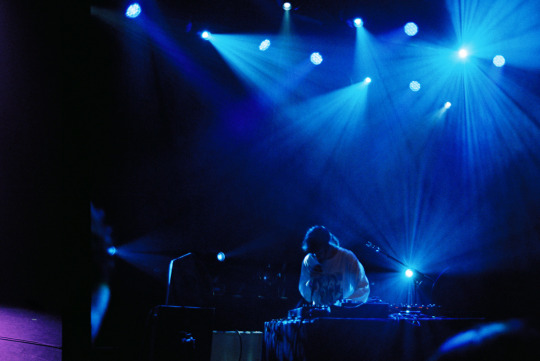
Our journey began in Paard II, the smaller room of the venue, with a dose of saccharine syncopated beats by Jessy Lanza. I fell in love with her childlike, pitch-perfect crooning when first hearing The Galleria, in collaboration with NYC producer Morgan Geist. Her solo work, while less club friendly, is infused by the same pop sensitivity coupled with heart-on-sleeve emotion and offbeat naïveté. On stage she was a pure sugar rush, enveloping the entire space in her sweetness. Struggling to get closer for some shots, I had a joyous run-in with activist and female:pressure ambassador AGF, adding another piece to the sisterly puzzle.
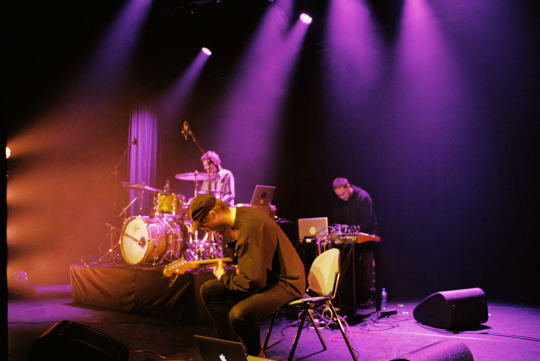
Across the street in the dark, cozy stage of Prins 27, the New York trio Zs had just begun their set. A fluttering guitar intro was filling out the space, just as a slowed down tribal drumming started, juxtaposed with doomy saxophone howls and computer glitches by a special first-time guest performer, evolving into a delirious cacophony, seeping in and out of chaos.
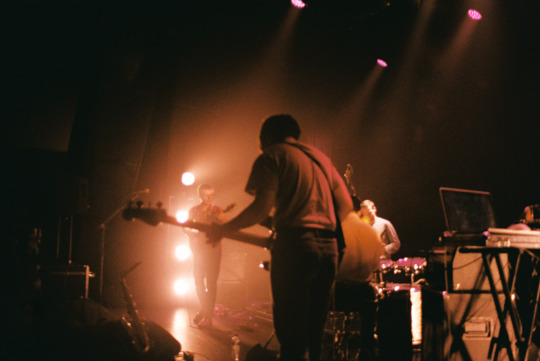
Coming back later to the venue for Horse Lords, I arrived in the middle of an all-enveloping, hypnotic, sinuous saxophone solo, emphasized by Max Eilbacher’s signature abstract electronics. Their second piece started off with quiet guitar finger picking, as the rest of the band was slowly joining in, soon turning into a full-on percussive explosion, with saxophonist Andrew Bernstein joining Sam Haberman on drums and Max picking up the bass. It was a nice change of pace to see them play with the dynamic and explore more meditative moments framing their more rhythmical passages.

Trances
Back at the Paard, the main hall was packed, resonating with the shoegaze chords of the Slowdive reunion, which transported me straight back to high school.
At the smaller stage, the crowd was anxiously trying to find a spot for the Forest Swords performance. The place was filled to the brim, with a line forming at the entrance. Luckily I had found a comfortable refuge by the staircase, with a great view of the performers in front of a large projection of a black and white photograph featuring a group of horsemen, bare-chested, riding into the sea. His majestic, dark yet danceable elegies and full-bodied beats were making the space almost claustrophobic, rending the room upstairs into a giant resonating box, with overwhelming bass, climaxing with the familiar refrain of Dagger Paths’ Miarches. After first seeing him in Paris back in 2014 and more recently on the big stage at Unsound, it was refreshing to experience this more intimate, focused performance.
Popping back into Paard I, Blanck Mass, the solo project of Fuck Buttons’ founder Benjamin Jonathan Powers, took us on a journey to the glitchier side of trance with stroboscopic, organic visuals bordering the grotesque. It felt like being transported into a scene from Enter the Void.
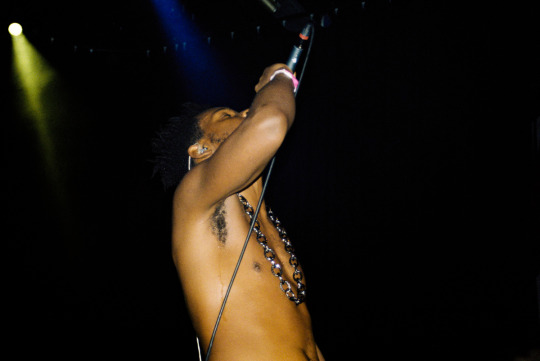
This brief excursion was the perfect palate cleanser before GAIKA, although one might argue that nothing could really prepare you for his confrontational, full-on performance. Once he was on stage, the real party started – there were young girls in the front row weaving their hands in pseudo-oriental fashion, bodies swaying to the infectious beats. Behind the contorted figure of the performer, armed with the microphone, a large, Viking-looking metalhead was assuring the backing vocals, together with a DJ. It was a powerful, raw display of emotion coupled with an uncontrollable desire for dancing.

Norwegian duo N.M.O provided the healthy dose of analogue techno workout from the middle of the crowd, crystallizing in the collective catharsis we’ve all been waiting for, complete with sweaty drumming and a Jérôme Bel-esque performance moment when the guy in the Sudden Infant shirt doing 20 air pushups as the sample instructed.

Arca’s DJ set, coupled with Jesse Kanda’s visuals, was one of the most fascinating instances of crowd work I have ever witnessed. He had the roomful of people in the immense space of Paard II fully in his power, toying with our emotions from pumping techno to Destiny’s Child and even a traditional Urdu song, while baby owls, fish guts and African puppies were staring back from the screen. As if he wanted to make us dance, then make us feel guilty for dancing, in a highly nuanced realm between abandon and discomfort. I would have loved to experience the more performative, outlandish costumes side Arca is famed for, but the overall effect was still utterly poignant.

Disturbance
Saturday started with a morning visit to the AGF/Kubra Khademi rehearsal; the meeting between the two artists happened a couple of years back online, after Antye read the story about the Afghan artist’s brave performance against female harassment in Kabul, which lead to her arrest and current exile. After meeting several times, over the years, the two artists developed ZANSUSPENSION, premiered at the festival.
The show was a highly moving interdisciplinary moment, featuring Kubra descending into the space in a body bag over AGF’s organic textures. Displaying strength and vulnerability, their collaboration seemed like the most natural thing in the world for both performers.
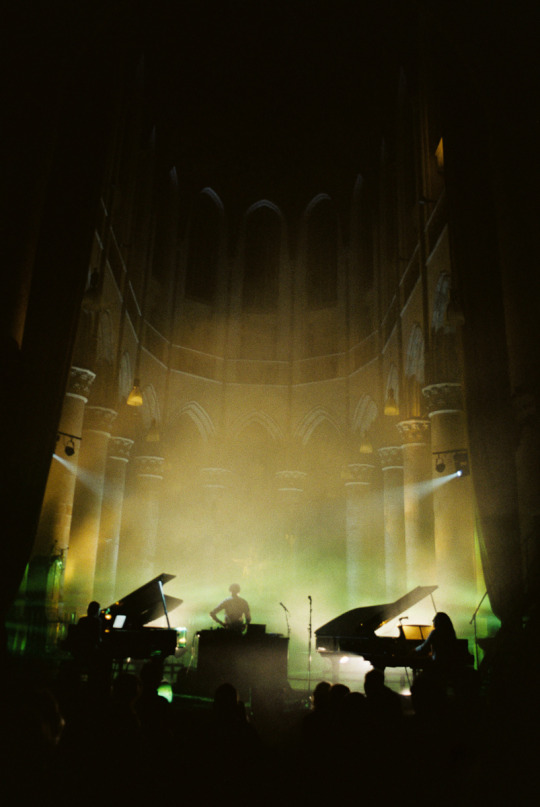
Skipping on the ensuing talk, I rushed to the Grote Kerk for Jayce Clayton aka dj/Rupture’s tribute to the late African American gay composer Julius Eastman. His minimalist piano pieces were resonating in the gorgeous space, the acoustics emphasizing the otherworldly nature of the score. It was a sublime, transportive moment. Jayce framed his tribute with a tongue-in-cheek self referential piece, a humorous and clever commentary on the role of the performer.
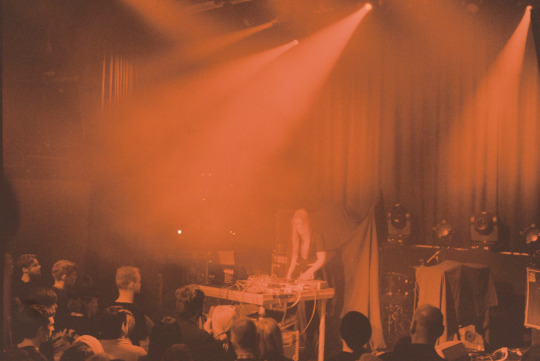
Sonic Sisterhood
Rushing back to Paard II, I was faced with a thick crowd blocking the entrance; I could hear Pharmakon’s world-shattering drones from the hallway. Entering the womb-like space covered in red light, I could finally hear her thanatic, visceral screams. Hers was a possessed, consuming performance, oscillating between electronics and her rolling on the floor with punk audacity, before surrendering to pure anarchy and descending into the confused but enthusiastic crowd. It was a good choice of programming to have Wolf Eyes play right before and set the tone.
Later on, I spotted her at Prins 27, looking very un-demonic with her blonde tresses and biker jacket. We were all waiting for Moor Mother’s set. Antye and Kubra joined us in the front row.

Behind a computer screen and two microphones, Moor Mother started off with a series of texts about black identity on an ambient background, with interjects on a toy theremin. About ten minutes in, things went 180 and I witnessed the most punk rock performance of the festival – she put on a fat grime beat, grabbed a microphone and started pacing and staring down the crowd, while rapping about protests and slavery, before jumping into the crowd for “Deadbeat Protester”.
It was an intense marriage of politics and club culture that would have made DJ Sprinkles proud.
Although the much anticipated club night was about to start in Paard II, it was SØS Gunver Ryberg’s dark blend of masterful analogue techno back at Prins 27 that helped ease out the crowd from noise into club mode.
Booking a series of headlining DJs in the small space of Paard II after all the other performances ended was a miscalculation on the part of the organizers, especially when selling extra tickets especially for the night, leading in general chaos and a frustrating amount of queuing.

Once again, it was the ladies who ruled this portion of the night as well, Aurora Halal’s live maze of kick drums and meandering beats leading the crowd into a beautifully orchestrated collective delirium.
The Swedes of SHXCXHCXSH went full darkness, but Helena Hauff’s gorgeous mix of Chicago, Detroit anthems and a hint of acid offered the perfect finale for this emotionally charged evening.
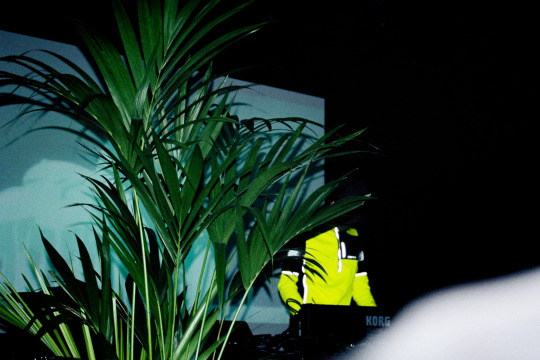
Although Croatian Armor, dressed in neon reflective active wear, delivered an eerie, subtle emo ambient set from behind a live palm tree and Swans had a kaleidoscopic, rich set, it was the ladies who shone through day two.

Sun Through Stained Glass
Sunday, as music festivals’ dynamics work, was the day of mustering all your strength to power through the rest of the event, moving in a dream-like state of bliss coupled with physical and emotional exhaustion.
I must have turned off three alarms before crawling out of my waterbed in a suburban villa framed by a large empty field with three wind mills and a goat farm (as bucolic as this may sound, it also meant I was staying real far), before making it back to the city.

Wandering between the various venues, I was too antsy to really settle on anything; however, back at the Lutheran Church, Dutch veteran collective The Chi Factory offered exactly what I’ve been looking for – a spot-on New Age ambient trip, complete with nature visuals and a floor full of beanbags. I took a seat among the rest of the audience dozing off while the last of the afternoon’s sunlight was creeping through the stained glass windows.
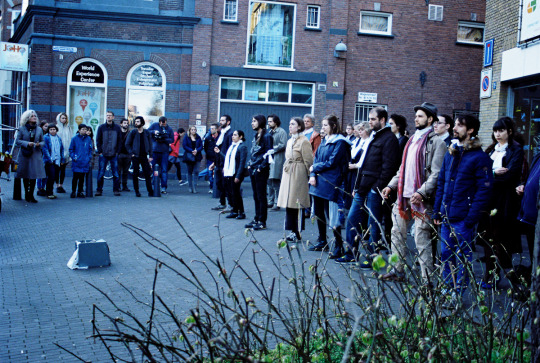
After his relaxing detour that made my inner hippie glow with joy, I stopped by The Grey Space to check out the Bertus Gerssen photo exhibition, after learning that many of the shots were taken in the infamous Villa K, a musician’s squat in the rich coastal Scheveningen district, which also happened to be my home for the evening. Instead, in front of the building, a crowd of about 40 people, carefully aligned, were standing still and looking straight ahead, wearing white scarves, while a text about guerilla warfare was blasting from the speaker, all to the confusion of both festival goers and passer-by. It was a performance orchestrated by the Das Ensemble Ohne Eigenschaften.
The highlight of the evening and personal festival discovery came from the British duo These Hidden Hands, whose deep, sleepy drones slowly built over more fleshed out beats, then burst into melody in a moment veering on the sublime.
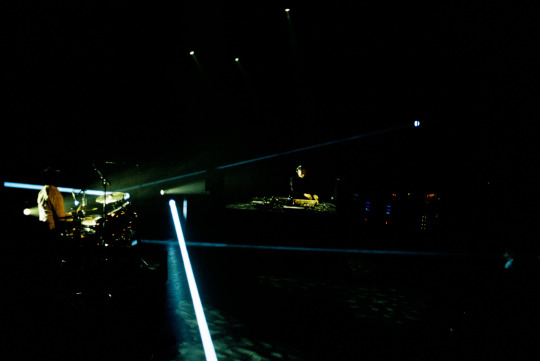
Back in Paris, a friend of mine commented that now “Jeff Mills comes to Europe to do his artsy projects”; to be honest, I’m usually skeptical of these live electronics and classical instrument collaborations, even if it’s between Jeff Mills and Tony Allen – it usually can be amazing or notoriously bad. Despite the two musicians being true masters, technical virtuosos in each of their field, this second meeting of the minds on stage was everything I feared it would be – a major let down. With the exception of perhaps 5 minutes when Jeff’s beats were erring on the more melodic side, nicely filling out the space alongside Tony’s drumming. The rest of the set was rather tinny and flat.
This result could be pinned on the limited rehearsal time due to budget issues. Then again one must argue about the catch 22 of bringing the main headliner to a festival in order to sell tickets yet not facilitate said performer to be at their best and debate the relevance of booking such potentially problematic acts in the first place.

The North Sea
The next day, with my feet in the sand, I was pondering over the intense three days. Looking back at the program, it seemed like the festival managed to touch on some major issues in contemporary society, while addressing the audience’s fears and desires on a more subconscious level. There was talk about activism and political engagement, a lingering penchant for ‘90s’ nostalgia and a proclivity for the darker sounds of the electronic spectrum, those that seem to capture the looming global tragedy, as if they had compiled a collective CT-scan that revealed our late night thoughts.
Its diverse, seemingly erratic choice of artists was actually making sense; I was very pleased with the way they addressed the burning topic of 2016 – women in electronic music. Instead of making a point out of booking female performers, they were seamlessly integrated into the lineup, offering a glimpse into a much needed new reality in which female musicians and DJs are simply referred to as musicians and DJs. As Jo Kali argued in her essay from the festival booklet, “feminism demands a radical cognitive adjustment, not just balancing numbers.”[1]
Enveloped by the calming sound of the North Sea, I could not help but think back at all the exchanges and support I received from fellow feminists during the festival, be it sharing experiences of odd sleeping arrangements with male hosts on tour, or the casual inappropriate touching by random men from the industry or simply Antye and Amy buying my broke ass a drink. Being surrounded by all these wonderful ladies was certainly a privilege.

Although the festival took place the same time as the Rush Hour Weekender, which catered to my usual musical obsessions, I’m happy to have had this rather challenging festival experience.
I believe Rewire has found a tremendous formula for luring club people into the more underground realms of the electronic music spectrum. And, if nothing else, telling your friends you’re a 15 minute bike ride from the beach is always a good argument.
[1] Jo Kali, p.42 There is no “single” woman, Rewire 2017 booklet
Rewire festival took place March 29th-April 2nd 2017 in The Hague
analogue photos by the author @feralnoise
#rwr17#rewire#rewire festival#agf#kubra khademi#jessy lanza#helena hauff#aurora halal#reviews#festivals#the attic mag
0 notes
Text
Sonic Protest 2016 Part I
for The Attic Magazine
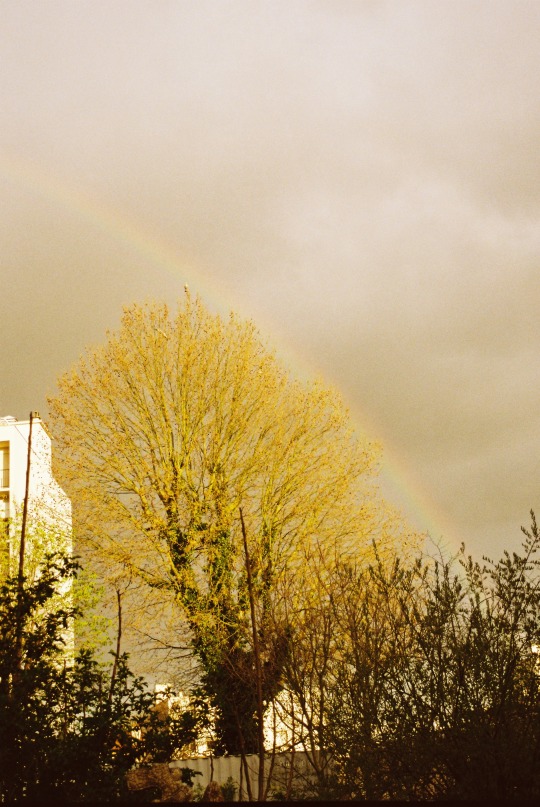
Prologue - Un temps tendu
''The atmosphere is quite heavy right now''; those were the first words my friend said to me, coming to pick me up from Nationale. Initially, I thought she was referring to her, as she recently moved in with her boyfriend, then she went on ''...you know, with the riots and everything''. I left Paris on November 16th, the Monday right after the shootings. I had been living there for over 5 years. This was my longest trip back to the city after the recent tragedy. It's strange how the events have permanently changed the city; in a way, you can't think of Paris anymore without terrorism in mind, just like you can't picture New York City without 9/11 anymore. I still recall the day right after the attacks - the panic and confusion that ensued. I was alone in my friend's studio and she told me that the people on the news advised everyone to stay indoors. I started to get claustrophobic towards the evening and decided to venture outside for some food. To my surprise, things seemed strikingly normal - people were chatting outside the cafes, taking the metro, going to the supermarket. Life went on. Six months later, it felt like the city was back to its usual pace and the November 13th tragedy was some distant memory. Only, unlike the Charlie Hebdo shootings the previous year that after many weeks of seeing the support message Je suis Charlie in literally every newspaper, bar or Facebook page, things were still tense. Place de la Republique remains the Gordian knot of an intricate conflict web that the authorities still can't seem to be able to contain. It's a big open space that could fill up quite quickly, located in the middle of several tiny streets. Republique has become that spot that illustrates the social clash between people who come to protest, skaters, and youngsters from the banlieue coming over from Bastille for a night out, yuppies from Le Marais, cops and homeless people. I remember the Sunday after the attacks; I took the metro to Republique. As the train stopped, there were people running into the train scared and crying, shouting not to get out. On a random night back in March, one of the exits was blocked and there were ambulances and police cars outside. And now, the riots. When I first moved to Paris, back in September 2010, the friend who hosted me suggested I should go to a manif. She described it like this somewhat entertaining activity, where the streets get blocked and people march drinking, singing and chanting slogans. And, of course, a typically French custom, that would help me understand the culture better. At the time, they were protesting against the new retirement age. And yes, it did feel like a big street party. But now riots have changed; there is tear gas and an alarming amount of police violence. I heard rumors about the things going on at Republique, how people started a sort of occupy movement and have taken over the place. My festival-related trips didn't bring me near the area until this particular Sunday, April 9th, when I was stuck in the metro with the doors closed for about 15 minutes for a security clearance at Republique. A big protest was scheduled that night, roads blocked, bus and traffic deviated. Having missed the last train, I got out on the square in search of a night bus, not really knowing what to expect. As I emerged from to the over ground, it felt like I was transported in a sort of Mad Max inspired reality, with slogans, street musicians, street vendors and even an urban garden improvised out of plastic bottles. They have been protesting for days against the new labor law, which would erase some essential advantages of the Front Populaire and their radical reform in 1936, making the 40-hour work week no longer compulsory. It was a tense time indeed.
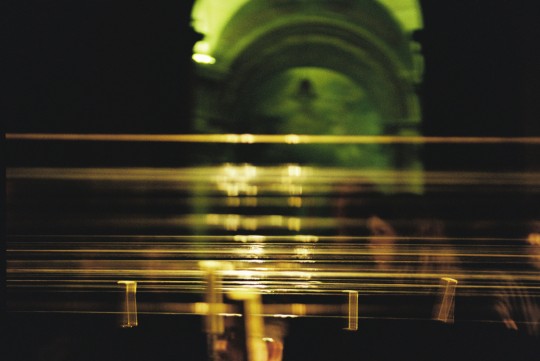
Instant Chavires' Day Out
For me, springtime in Paris was spread around the three major underground and experimental music festivals that accompanied the changing of the seasons: Presences électronique in March, Sonic Protest in April and Villette Sonique in May. Attending these events or simply looking at the line-ups and making plans were a yearly rite of passage, fully part of my daily life. It was just like a series of solstice rituals, which happened organically. This year was the first time the festival was not just something in my life, but an event I built my calendar around. Going to Paris specifically for the festival operated a shift in my perspective, making the entire trip an event. Given the whole social context this year, the festival started to gain a series of new political connotations. Or, I was perhaps starting to decipher new metaphors within the music. Even the name, Sonic Protest, felt like a sort of slogan. Within the so-called 'experimental spring' of Parisian festivals, Sonic Protest is probably the most dashingly diverse. Framed by Presences électronique, GRM 's showcase of electro acoustic, experimental and modern composition, and Vilette Sonique, on the more pop side of the underground spectrum, Sonic Protest is a very unique endeavor both in terms of programming and funding. The festival has been around for 13 years, with Arnaud Rivière and Francq de Quengo as programmers. For the connoisseurs, Arnaud Rivière is also the guy behind the cult venue Les Instants Chavirés in Montreuil, a DIY space for experimental music that has been around for over 20 years. Although Instants Chavirés is partially funded by the Mairie de Montreuil, Sonic Protest is mostly a self-financed affair. The diverse programming at Les Instants (internationally, Cafe Oto in London and OCCII in Amsterdam could be considered kindred spirits) blending noise, ambient, free jazz, no wave, weird folk and experimental techno among its genres (last year Les Instants saw Black Zone Myth Chant, a High Wolf psychedelic side project and LIES artist Lowjack play the same bill, for example).
This sort of hunger for new and exciting music is at the core of the festival. However, unlike Les Instants, which can feel pretty packed if there are 100 people inside, Sonic Protest has the luxury of playing with bigger venues. It almost feels like Sonic Protest is Instants' field day - get out the big guns and let's have some fun! The festival stretched out for two weeks this year, with the main series of 8 concerts in Paris, followed by events in other cities in France and Belgium. A sound art exhibition and a series of film screenings and conferences were also part of the program. I could only attend 4 shows this year, but they were the most impressive, core events of this noisy shindig.
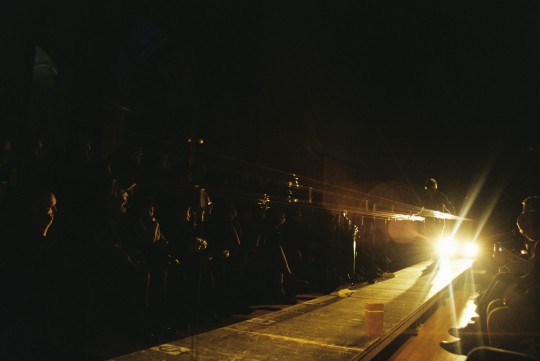
Modern Elegies
I arrived in Paris Wednesday morning, after a sleepless night and a 6 am flight to Beauvais Tille, also known as the bus stop airport. Porte Maillot, with its shuttles and cheap bus rides, brimming with immigrants and Asian backpackers was a much too painful déjà-vu. Only this time I wasn't headed to my 5th floor walk up with a terrace in Clichy, but to and a couple of nights on an air mattress in my friend's new apartment, still filled with moving boxes and lingering paint smell. Getting accustomed to the 10-degree temperature drop from Bucharest, all I could think about was sleep. As I rushed towards the already familiar sight of L'Église Saint Merry, this catholic church by the Kandisnky fountain, right near IRCAM and Centre Pompidou, I was already back into my grumpy Paris self, cursing the crowds at Les Halles and sporting a permanent frown. Last time I was there back on a cold night in September, when John Butcher did a solo and Eliane Radigue presented one of her new acoustic, orchestra pieces. There are three things you need to know about this church - it's extremely cold, the chairs are notoriously uncomfortable and the sound is always challenging because of its architecture. For the first time, I felt like Saint Merry found the perfect performance for the space in Ellen Fullman's Long String Instrument. I first saw a movie of this piece in a show at Le Plateau and I remember being greatly impressed by the physicality of the instrument. Now, it was a question of scale - stepping into the empty space, with only a couple of people from the festival staff shuffling around preparing for the big night, the sight of this 30 meter long catwalk surrounded by strings that took over the entire nave was quite breathtaking. The entire installation was wrapped in traffic tape, an extra security measure for this robust yet delicate instrument. The resonating strings were held together by 15 large 35kg sand bags on each side.
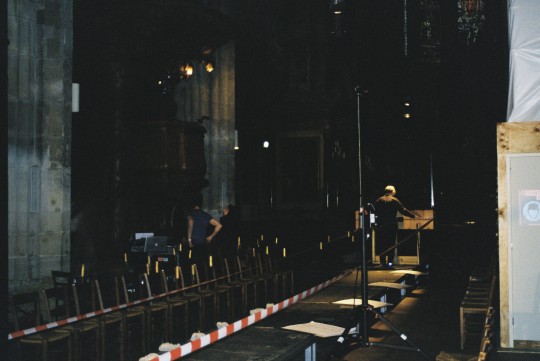
A fragile silhouette, not much taller than 1.60m, dressed in a nondescript black windbreaker and sneakers, was walking among the strings, making final adjustments. Composer Ellen Fullman was a particularly discreet presence, with her short white hair, tiny glasses and a gaze suggesting perpetual curiosity. Part of the wave of great minimalists, influenced by Alvin Lucier and Harry Partch, she is a lesser-known figure among the average contemporary classic music fan. Just like Eliane Radigue in France, her incredibly innovative work has been marginalized until the last decade. This was to be her first performance in France and it was no surprise that Eliane Radigue, the other great lady of deep drones, was there to support her. The two together, chatting, made for an endearing sight and an important page in the history of modern music. Later, at the communal table, I somehow ended up at the same end of the table as them; it was surprising how everyone from the staff was just going on about their dinner, while the two ladies were wrapped up in their own private bubble, sharing ideas about each other's work. The one thing that caught my ear was Ellen asking Eliane about her notation system, to which she replied that she didn't have one and had to explain to each performer how to play her pieces. Returning to the church, I could see all the intricate series of numbers scattered across the wooden walkway, from sheets that looked like scores to numbers marked near the resonating wood boxes or the stones that were weighing down metallic clips onto the strings. I didn't know if I was looking at a Carl Andre/ Daniel Buren hybrid piece of sculpture or at a gigantic, gutted prepared piano.
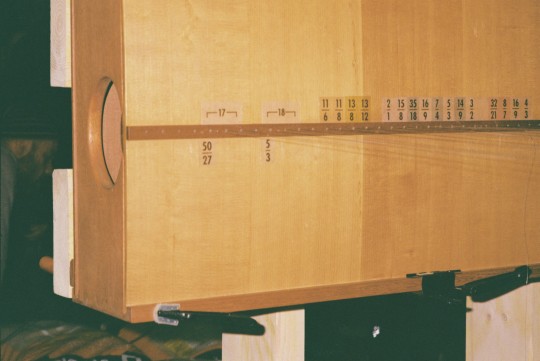
Soon, the spots behind the seats and those between the rows started to fill; some younger kids were even sitting on the freezing church floor in front of the chairs. We were gearing up for a sold out evening, which, given Saint Merry's capacity, meant around 600 people. Then, the large stage lights went on; the tape was cut. The audience was growing restless in anticipation. Ellen took to the stage and started gently tapping on the strings at the left end. The beginning was very low and subtle, certainly not enough to drown her out. My angry glaring certainly didn't help. Then, something changed. The whispering stopped. Everything pretty much stopped, for that matter, as Ellen's piece was slowly growing bigger and more resonant. Even the photographer stopped taking photos, as if embarrassed by the sound of his camera disturbing the silence of the piece. It was as if the entire audience was swept by this large wave of emotion, drowning everything in its way. The metallic drones grew deeper and deeper as Ellen was walking across the platform, as if in a trance, like a shaman trying to control the fire of her vision. It sure was a strong beast to tame, this grandiose, unusual instrument.
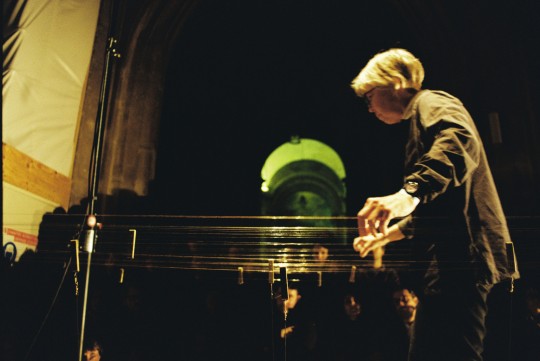
If in the first couple of minutes people were still holding out their phones, documenting this strange sight, they quickly started to let go and patiently listen to the slow progression of the music. I don't think I ever heard the church audience as quiet as that night. There was a sort of collective concentration, a group focus that felt almost electric. The drones started getting deeper and deeper, evoking dark visions that were slowly growing darker. I didn't even dare look at Ellen, although her small but stern fingers kept moving across the strings, barely 20 cm away from me at times. She was looking down, carefully following her notes. The atmosphere started to get darker; you could sense the thick layer of emotions she conjured. Everyone around me was frozen, possessed. About five seats down from me on the opposite row there was this blonde woman, ducking between the passageways left between the seats. She was on her knees, looking up at Ellen, fist clenched under her chin. Her eyes were wide and moist and mouth vaguely agape. The composer kept her slow pacing up and down the catwalk and this lady's stare was following her every move. The next time I looked at her, I could see the black smudging of her eyeliner giving her a hazy look. As the piece progressed, I was more and more fascinated by this woman, whose mascara started dripping by now. It's as if she was expressing a sort of ancestral suffering awakened by the music, in a sort of Madonna pose bearing all of our pain. Maybe she has just recently broke up with her boyfriend or was going to some other very personal drama; either way, the music sure struck a chord with her and there she was, full-on crying for all of us dry of tears. It was such a touching portrayal of this large, sad, beautiful music. By the end of the first piece, I must have seen at least three people barely holding back their tears. Then, the music stopped. It took about 45 seconds for the last chords to finish resonating before the church broke into a frenetic applause. It was a cathartic moment, as if a heavy lead blanket had been suddenly lifted. I believe that if she kept going for even a few more minutes, we might have all ended up weeping.

Visibility uncomfortable by the overly enthused round of applause, Ellen muttered a quick 'Thank you' and rushed to the middle of the walkway to turn on a motor for her next piece. This was a much shorter and lighter effort, the constant movement on the string giving it an almost jolly undertone. Again, an explosion of applause and ''Bravos!''s followed. I think the composer was slightly startled by this utterly warm welcome and slightly annoyed for having her set interrupted. She then placed herself at the left end of the catwalk, where the resonating boxes and loose ends of the strings were. She started rapidly pulling on them, building up an alert pace of higher tonalities. At first it looked like some kitten playing with the extra string hanging from the knitting basket and we weren’t even sure if she was playing or simply started undoing the installation. This roughly 5 minute piece has the much needed playfulness after the first long meditation. It almost felt like a hopeful glimmer of light that would help us get out of the dark world she has previously ushered us into. Things moved quite quickly after that – the staff started moving the chairs, uncovering the sand underbelly holding together the whole apparatus. The transition was probably a little too abrupt but they were already behind schedule and there was no time to lose. I felt like even if that was the only thing I got to hear during the festival, I would go home happy. As I went outside for some air, I almost couldn't fathom coming back and listening to more music. Ellen's piece was just that overwhelming. Even if you didn't enjoy it, it still had quite the impact. The whole experience was quite humbling.

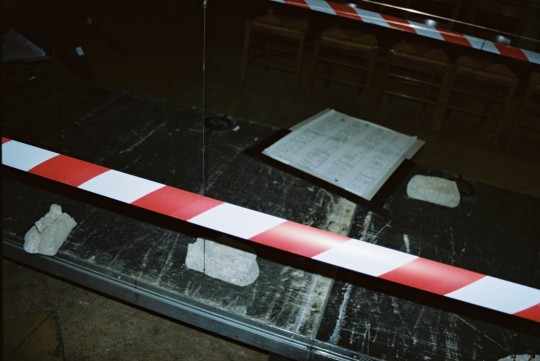
I heard the sound engineer talk to some other guy afterwards describing it as ''heavy''. At the same time, especially after that first taste of returning to Paris and all the turbulence that ensued, it felt like the most appropriate thing one could listen to in those messy times; something that played on our fears and pain, exposing it into the music. Ellen's elegy had strangely specific undertones in her universality.
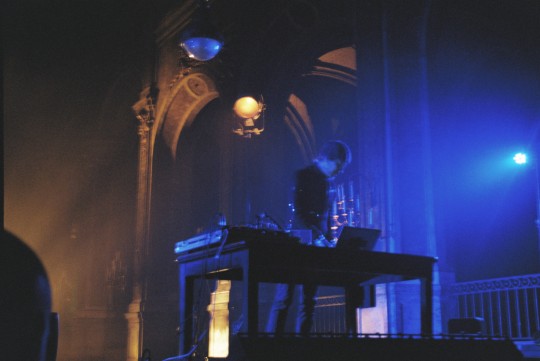
End of the nave
Going back inside, I arrived in the midst of the usual Saint Merry concert sight: people gathered around the bar side, talking quite loudly, a couple of curious spectators by the improvised record store booth and a few dozens of people standing, crowding in front of the altar stage. On stage, a guy in mid-thirties, with a small beard and fisherman's beanie was playing medieval-inspired laments on a violin drenched in electronics. He looked like the wandering bard you would read about in fairy tales. Yet his approach was somewhat oblique, wearing his pop and chanson heritage on his sleeve. While most of the songs were slightly upbeat and even had dance potential, there was something utterly sad in the air. I knew my mind was still tangled up in Ellen's strings and for some reason couldn't commit to the young bard's tales. Even though they felt like songs from a dead king's banquet, there was a celebratory element that felt slightly inappropriate. Given another context, I would have probably been more inclined to delve into Sourdure's pagan folk. It was probably just my overall tiredness or the length of his set, but the evening was just a little too dense. There was a moment when he paused, put down his violin and started addressing the audience; he told us that in medieval times, there was this custom of people from the village to go from house to house asking for food, while singing songs. Then he shared an acapella version of one of those songs. In the dimly lit church, I felt transported into a caravaggesque time where everything happened in dark little room by candlelight. It seemed like he conjured the entire magic of his set in this stripped-down 3-minute song. Basinski's set took me by surprise. This was the moment we've all been waiting for: hearing the new piece by the tape drone master made for a highly anticipated set.
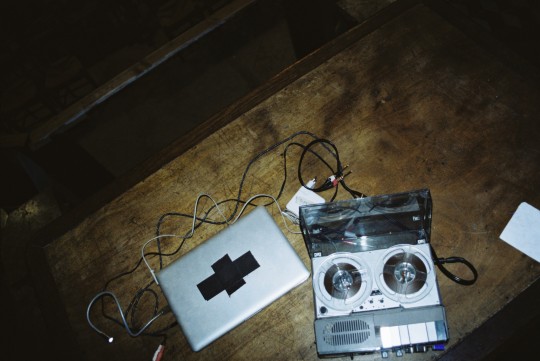
I managed to shimmy my way up front, to feel those loops right in my guts by the subwoofer. The feeling was quite intense, giving the enveloping effect I was hoping for. Only the cold marble of the church didn't make for a very comfortable listening spot. Some kids around me were sitting with their eyes closed, in a semi-conscious state, caught up in William's daydream. As I rose from my nosebleed seat, the sound started quickly diminishing, losing most of its low-frequency intensity. Instead, you could hear this dark ambient music reflecting on the tall church walls. It seemed that the crowd around the stage grew even bigger. Some people pulled up chairs to the side and were listening patiently. The music felt like a soundtrack for all these strange audience members, elongating their necks trying to catch a glimpse of Basinski or standing on chairs in order to take a good photo. And he was just slowly moving into the blue light, wrapped up in his sequin jacket, sporting an absent smile. It reflected the light beautifully; for a moment I even thought his jacket was actually made out of LED lights. I spent the end of his set towards the very end of the nave, hearing all the resonant frequencies break onto the walls. His piece had the classic beauty of his previous work, the same drawn-out elegant sadness, yet somehow I couldn't fully enjoy it. Maybe it was because all of the hype created; I'm sure I wasn't the only 20-something who came to the festival especially to see him. They say it's not good to meet your mentors; in William's case, the live experience felt a bit underwhelming. Not that his music didn't make for a very touching experience, especially in the gorgeous space of Saint Merry, yet I felt like something was missing: his sadness was too overtly beautiful yet light, almost sporting a pop sheen. Maybe Basinski finally figured out how to emulate Eno's Music for Airports after all. Which was one of the things I loved about it in the first place – this baroque, aestheticized sense of suffering. However, it didn't hit me in the gut this time. Ellen's piece felt raw, almost brutal in comparison. The audience scattered quickly as the show ended, either running for the last metro or hoping for William's reappearance for a selfie or an autograph. While the engineers were packing up his setup, one tiny silhouette was contemplating the space, empty once again. It was Ellen Fullman, that somehow went unnoticed by the remaining groupies, still chasing after the glittered Basinski unicorn. I wanted to talk to her, but she seemed too deep in her own thoughts to be disturbed. This great tiny lady was surely brewing up another storm.
0 notes
Text
Sonic Protest 2016 Part II
for The Attic Magazine
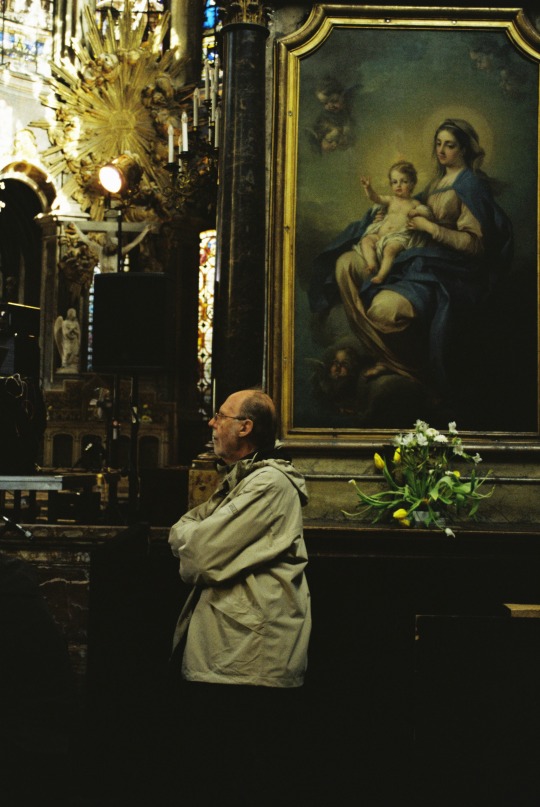
April in Paris
Parisian weather had always been capricious, to say the least, but during the festival week it seemed like someone was pushing the rain and sunshine buttons at random.
April in the city sure didn't have the romantic nostalgia of the Van Duke song, rather bursts of joy followed by frustrated fits. However, the fury of the elements didn't seem to intimidate the crowd, that still showed up for the events in healthy numbers.
Although the chestnuts were not yet in blossom, the feeling of spring renewal was in the air: people had an added gait to their step and sometimes even smiled. There was a certain joy reflected in the blooming trees and side road daffodils, with the promise of picnics in Buttes Chaumont and wine along the Seine.
During the moody afternoon of the second day, I enjoyed a brief moment of sunbathing in the unlikely small park by Chatelet between an interview with Erik Minkinnen in the 6th arrondisement and the sound check at Saint Merry.
Centered by four large speakers, Joachim Montessuis was struggling to get acoustics of the church to succumb to his massive drones. The entire building was resonating with his earthy drones. The sound was so powerful that a couple of strangers walking by the church stopped by to inquire about what was going on inside, intrigued by the sonic out pour.
The metal heads from Aluk Todolo were walking around the sun-drenched church, taking advantage of its impressive decor by posing for what looked like subversive band photos.
However, the long-awaited AMM reunion was all everyone could talk about; how they haven't performed together in almost 20 years, how this would be their first show in France as a trio, how strained or not their relationship really was...
Gwen, the PR person, was telling me how hard it was for her to find a photo of the three of them together for the event. No wonder they looked so young and handsome- the picture was taken in 1974!
Soon, Eddie Prevost and Keith Rowe appeared, accompanied by his wife. They came to check out the venue before the sound check. They seemed to have lost John Tilbury, again.
When he finally showed up, he seemed to take more pleasure in chatting up the young lady in charge of programming at Saint Merry than hang out with his band mates.
After their setup, I tried to urge them to pose for a group photo; while Eddie and Keith quickly complied, John was nowhere to be found. He then showed up eating a piece of cake. In the end Eddie managed to bring everyone back together and for 30 seconds he managed to keep the group together. It was almost show time.
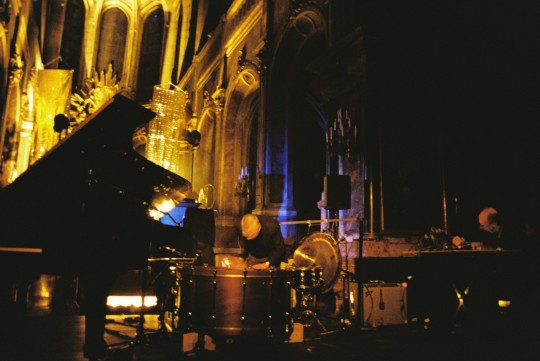
The Magic Hour
The crowd started taking their seats, quietly. The church looked less crowded than the previous night. However historical the AMM reunion might have been, it didn't seem to produce the same amount of hype as William Basinski's presence. While the free improv and jazz crowds can be very devoted, this type of music doesn't really cater to the young and hip demographic as much.
It was almost 8.30; the last rays of sunshine were still pouring in through the stained glass. Two large, golden panels were hanging from the ceiling behind the improvised stage in the choir's nook.
The panels were catching some of the light of the setting sun, bathing the church in a beautiful yellow glow.
Photographers call that time of day the magic hour, when the light naturally has this beautiful, warm tinting. Terrence Malik even shot an entire movie using only this kind of lighting and called it Days of Heaven. There certainly is a special sort of sentiment associated with this time.
The crowd waited patiently. There was still light out when the band finally took to the stage, welcomed by a pious yet vigorous set of applause. You could sense a special type of worshiping taking place, the church growing more quiet than a field on a snowy day.
I had a strange feeling of déjà vu watching Tilbury at the golden-framed piano; I then recalled seeing him perform at CAC Bretigny about three years ago, in a gallery space covered in the same space foil.
The three sure did take advantage of the self-imposed silence, starting their set as quietly as possible, as if testing the limits of the audience. John was clacking the small cover of the piano before touching the keys, while Eddie was gently caressing his drums and Keith barely turning on his guitar amp. This fragile web of sound and silence was soon interrupted by an unexpected yet familiar presence: someone was playing the melody from the Pink Panther outside the church, probably one of those street musicians you see around the Kandinsky fountain. The theme was hauntingly disturbing. While many may see it as an intrusion that ruined their set, I think it was more of a way to welcome the outside world into their session, like John Cage opening a window to the New York traffic noise. This familiar yet distorted melody brought an interesting contrast to the beginning of their almost silent set, emphasizing the kind of barely there sound they were challenging.
Slowly, the sound grew denser, becoming more organic by the minute. The golden panels were gently swaying, moved by an invisible breeze. The church was dark now, illuminated by a couple of yellow lights. Despite their dynamic in real life, their stage presence was flawless, weaving a complex form of abstract narrative together. You felt transported into a world of pure sound, where instruments became real natural elements, taking a life of their own. It was just like everything you ever heard done in the realm of free improvisation, but with a freshness that revealed their incredible skill and constant curiosity toward music. When done poorly, any extra minute of an improv concert can feel excruciating. In AMM's case, the 50-odd minutes flew by unnoticed.
The light reflected on the golden panels made it seem as if the magic hour was taking place inside the church; that or just the surprisingly warm feeling generated by this atonal, adventurous music.
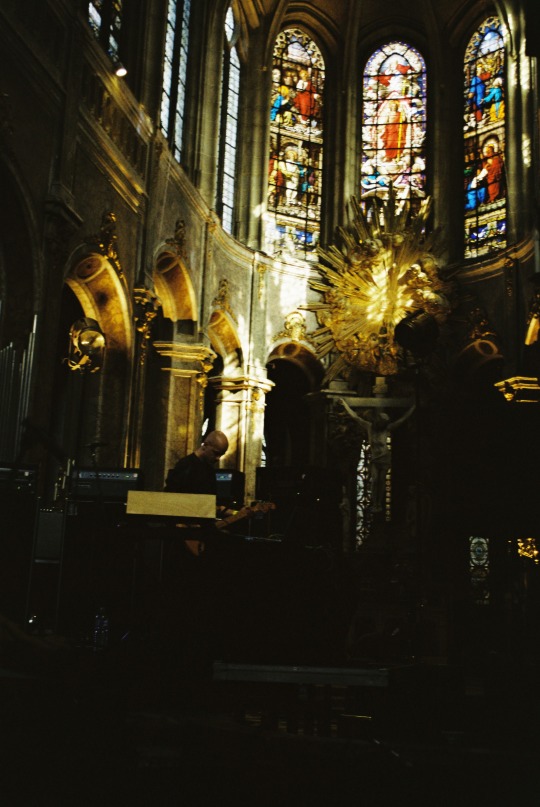
A Large, Resonating Space
It was hard to come back to Earth after AMM's mesmerizing set. The evening a different turn after their powerfully gentle showcase of improv virtuosity.
The seating was quickly cleared out for Joachim Montessuis' set, as if his drones needed the physical space as well in order to roam freely. He started unleashing his noisy drones to a slightly more compact crowd, eager to take in the powerful sound.
With the aid of a guitar and electronics, he was slowly building a wall of noise. You could hear the influence of doom drone masters Sun O))) in his sound, especially in the way the music was trying to take over the entire space.
Huddled inside this cocoon, the audience entered a state of deep listening, getting more comfortable with the overpowering sound as it kept going around the church. He had chosen a very particular way of propagating his drones, inducing a sort of flowing wave pattern in favor of the more compact approach usually employed in this niche.
The entire church became a large, resonating box and, just as during sound check, it was almost more interesting to witness from outside than within. I was about a dozen teenagers knocking at the church door, trying to make their way inside, puzzled and excited by this sonic force. It sure made for a confusing and comical experience.
Unfortunately, not the same can be said about Aluk Todolo, the rockers everyone seemed excited to see. While their set promised the sort of confrontational approach inspired by Joachim's music, their more metal-oriented endeavor fell pretty flat.
Some blame this underachievement on the lack of a more frontal, confrontational space, claiming their set would have worked better in a tighter venue such as Les Instants, while others brought up tensions within the band. Either way, it looked more like much ado about nothing.
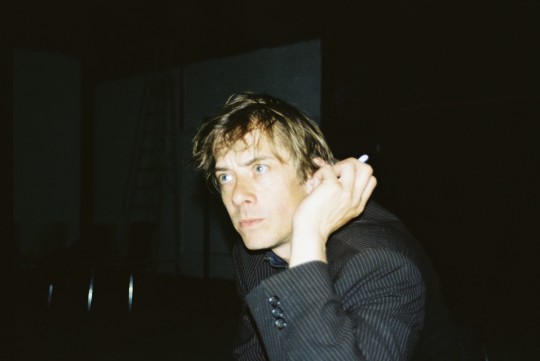
An Evening With the Prince of Darkness
The third night was fast approaching, featuring local legends Sister Iodine and new wave legend Martin Rev from Suicide. You could feel the crowd brimming with anticipation.
I arrived early, hoping to spend a little more time with the other members of Sister Iodine, after my lengthy discussion with Erik the day before.
The night's venue, La Parrole Errante, took the party back into the hip suburb of Montreuil, also known as the Williamsburg of Paris. The space is an enormous open hall with tall ceilings and no windows, painted black. It has the austerity and scale you would normally associate with techno parties. Surprisingly, it doesn't host raves but poetry nights.
The place is so big that even during a sold out night with the large main stage, the sound stage in the middle and label booths in the back, it still remains a third empty.
The backstage is as industrial and democratic as the concert venue, with large tables for the bands and crew in a loft-like space. I was hoping to get a few shots of the band together, but the only one I managed to steal was during the pre-show recon session with the sound engineer. Trios have a strange dynamic: the members easily break into duos and solos. Just like in AMM's case, the guys seemed more preoccupied with their own thing – Nicolas with his girlfriend, Lionel with his Ricard and Erik busy scribbling lyrics for his set, papers that always get stolen by fans, he said.

If you will, Sister Iodine are like the Sonic Youth of France; came up over 20 years ago with an unique sound ahead of their time, had a huge influence on the local scene, did countless collaborations and solo projects and have very devoted, cult-like following. That is if Sonic Youth were a self-destructive, highly nihilistic trio with a penchant for the occult. However, the most remarkable thing about them is how down to earth and approachable they are in real life. If you saw them hanging out, you wouldn't be able to anticipate the sort of self-devouring fire they manage to conjure on stage. They're almost jolly drinking buddies.
Their set oscillates between deep, dark drones and desperate, consumed howls, all guided by a deeply ritualistic drumming.
There is something utterly cathartic happening on stage, a sort of contagious energy that envelops the crowd, as if possessed. Besides the regular head banging, I witnessed the most exuberant forms of dancing to dark music I could ever imagine. There was a lot of jumping and turning around in circles, but the most touching moment was this couple at the very back of the room trying out a sort of interpretative modern choreography. Actually, it was the girl showing the guy a set of slow, large moves, encouraging him to create his own special dance.
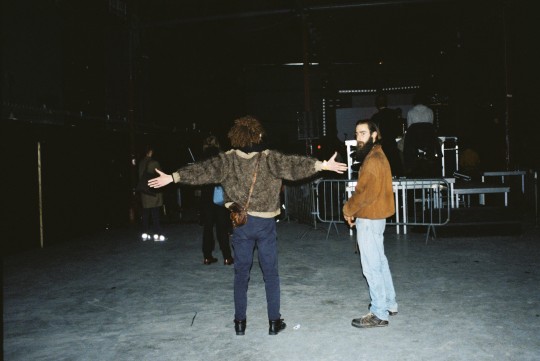
I spent the rest of the night following Erik, hoping to finally do the little band photo shoot I was promised. Only the members seemed to disperse even more after the show than before.
I wasn't very impressed with Somaticae's set, which felt like the compulsory moment of analogue techno they squeeze in every year, probably done by some Cergy alumni. I was telling Erik I don't agree with this gratuitous destruction to which he replied, visibly excited ''Oh, but this guy sounds really good! We're brothers into destruction!''. In this light, I decided to stay on and give it another chance, although my intuition felt about right when even my dark techno-loving friends concluded that he just ''had his moments'''.
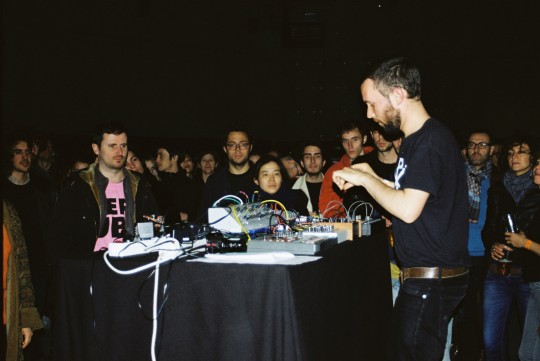
The biggest disappointment of the evening was yet to come. The mostly younger crowd was still riled up from the previous set when Martin Rev came on stage. Dressed in a tight vinyl tank top and pants giving him a wet look, Martin started banging on his keyboard trying to create some form of agitation. He had that ''I couldn't care less'' attitude with his Oakley 100 C neon-green cyclist sunglasses and matching belt, yet you could obviously tell he was feeding off the crowd as much as he despised them. It was the old ''hate them and they'll love you trick''.
Musically, his overflowing set had the same douche-y bravado, performing over an hour of mishmash ranging from Latin, funk and jungle to bad 80s cheesiness. You felt like you were in front of a legend, for sure, but more someone who was just a carcass of their former glory like late, Las Vegas Elvis rather than a true master.
With his gut spilling out of his shiny suit and clearly stardom-stung attitude, the comparison didn't seem far-fetched.
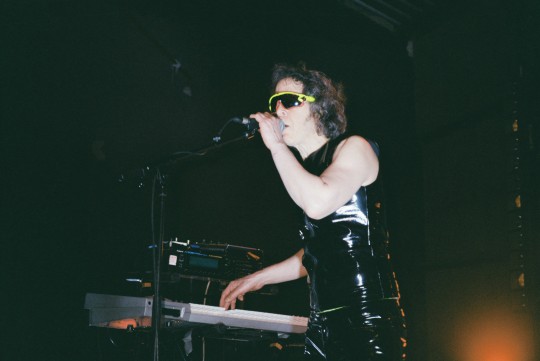
With his ruffled hair, ill-fitting suit and hunchbacked pose, Erik Minkinnen was the true Prince of Darkness, hiding an all-consuming fire inside his humble figure.
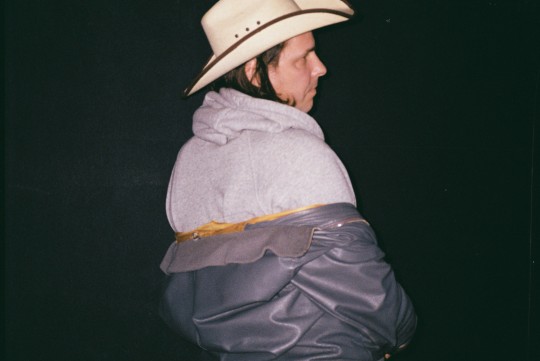
Totems, Fetishes and Dance Lessons
While the weather still couldn't seem to make up its mind between rain or shine, Saturday quickly ushered in the last big concert night of the festival. The newly formed rainbow visible from the venue's yard was a beautiful omen for this celebratory evening.
We were promised a particularly festive night and I felt was more than ready to dance it all off.
My host Nicolas was equally excited for the evening, which he described to me briefly saying ''oh, Api Uiz is always good, Circle are this cult metal band which should be interesting, I saw Quintron before and he's amazing and Konono is well...Konono''.
I have to admit I was mostly looking forward to the big Konono finale, but I trusted Nicolas' taste enough to keep an open mind for the rest of the evening.
Api Uiz are another French veteran band doing this instrumental dance-rock with Celtic, punk and Latin influences. While the crowd seemed pretty into it, the constant energy plunge felt slightly too brutal for an opener. They had a fun vibe, but it would have probably worked better if it was 30 minutes shorter.
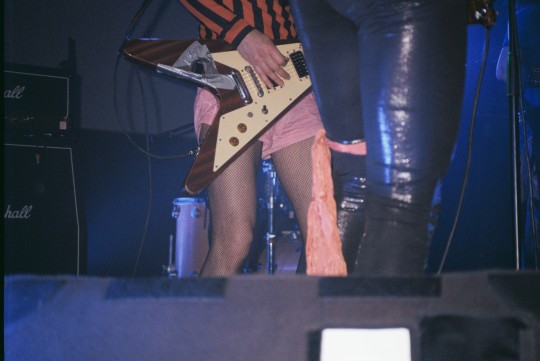
Circle made for a very entertaining show, taking a page from old rock'n'roll dress codes and sporting fetish gear, fishnet stockings and other glam rock paraphernalia. A friend of mine was utterly annoyed by their music but gave them props for upstaging Steven Tyler in the costume department. Their sort of self-deprecating, humorous approach was something to be appreciated both in the metal world and for musicians in general.
I can't say I was swiped off my feet by their music, but watching them climb over their instruments and goofing around was pretty engaging. It made for the true oddball moment the festival is famous for.
Although the true moment of pure weirdness was in Quintron and Miss Pussycat's set.

Even Princesses Are Renting
Don't know if there's something in the water in New Orleans, but the cultural melting pot can breed some particularly strange hybrids.
Such is the case with Quintron and Miss Pussycat, giving an excellent example of DIY done right. After Circle's display of Scandinavian metal marchioness, the stage was taken over by a big, colorful cube that looked as if some sort of monster vomited out the fabric section of a thrift store. What looked like a flowery colorful blob soon turned out to be a stage! The lights went on, small curtains were pulled away and the show began. With puppets.
Only in their case there was nothing innocent about the fairy tale. Ok, it had talking cloud and mountains and starred a blonde young lady by the name of Princess Diamond Sky Riverdale who was also The Chosen One, with a crown and everything. Oh, the beloved trope of the fairy tale! But, instead of the classic prince charming scenario, Miss Pussycat, assisted by Quintron on voice and sound effects, weaved a modern fable on contemporary living which, despite the surreal setting, felt uncomfortably real.
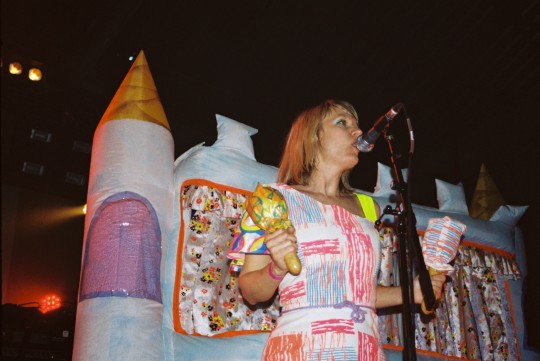
Let's just say that Princess Diamond Sky Riverdale was more of a Hannah Horvath/Frances Ha character than a khaleesi – she wants to move to Goblinsberg and needs a place to live. A parade of houses ensues: we have a horrifying sky scraper with metal teeth that asks for a ridiculous amount of gold for a one-bedroom, with draconian clauses. Unfortunately, that sort of real estate abuse is too much even for a princess. A friendly house follows, only to reveal that she has no more room left and her walls are also gone. She then meets with the mayor, the skyscraper's girlfriend and tries to work out a deal. Things don't really go as planned, as how could you trust a goblin with a pointy witches hat who clearly wants your crown? But I won't spoil it for you. Let's just say the development is well...pretty unexpected. In a good way.
This story pretty much resonates with anyone who's ever tried to find sensible accommodation in the Big City, be it London, Paris or Wiliamsburg.
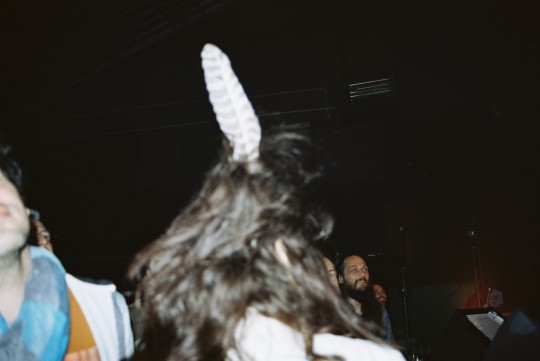
A feathered fan and that weird light bulb thing
The show really takes off with Quintron getting behind his one-man-orchestra setup of DIY instruments and handmade electronics. He sits behind a table complete with car lights and a bobble head holding the American flag, gently swaying with the beat.
I'm slightly embarrassed that I haven't heard about them before, since they seem to embody everything I love about experimental music – unique sounds, handmade instruments, a real penchant for dancing and wacky theatrics to boot!
What followed could only be described as very, very delirious dance music; it had the type of infectious energy that I only seen at Gang Gang Dance live right around Saint Dhyphma. The perfect blend of experimental out-there-ness coupled with a very primal understanding of rhythm, causing an almost instant desire to dance. Of course, it was all from the fringes of the alternative/indie realm rather than club music, but it was one of those instances when people from a more rock-oriented background embraced the unrestrained power of percussion and electronics. The crowd was still a bit taken aback, as French audiences usually are, feeling a bit apprehensive before surrendering to the groove. Luckily, as during all my good dancing-concert experiences, there was an outgoing American girl jumping and shouting in the front row with her SO. In this type of situation, having someone who's super into it and not afraid to show it makes for a great icebreaker.
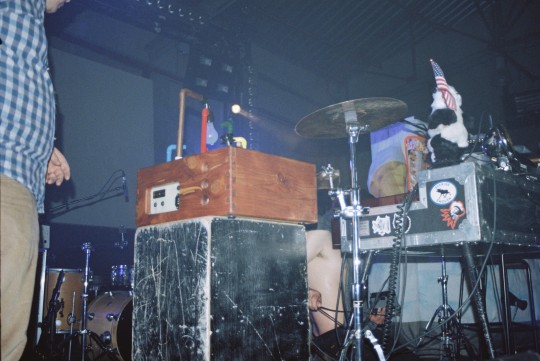
My ultra-fan was sporting a hawk feather, native-American style and was singing along to the mostly mumbled choruses about alligators, cats and other creatures. And, added bonus, she was probably twice the age of the drunk Brit broads and American Indierellas you could spot at Point Ephemere and Glazart among the front-row dancing crowd.
There was screaming, lots of intricate button-pushing and more dancers coming out of their shells.
By the end of their set, it felt like the party could have gone on all night. The crowd had clapped yearning for more, in spite of Quintron's exhausted but happy smile. He was shirtless and drenched in sweat.
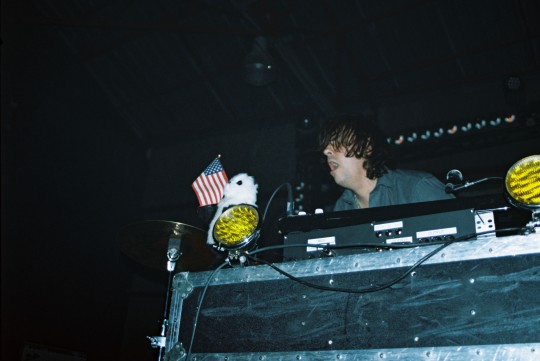
The duo has been at it for over fourteen years and the result is a tightly-knit display of playful craziness, in all its colorful glory. Quintron is sitting behind his car front table, banging on a drum, while a series of loops are playing, pitching a lap steel guitar and singing, while Miss Pussycat is playing the maracas in a neon asymmetrical dress and adding vocals as well. It's hard to make out his full setup from the front row, but I caught a glimpse of a cardboard turning bass device and what can only be described as ''that weird light bulb thing''. It's funny that my friend Jim, who was already familiar with their work and had seen them in Michigan suggested I should approach them and ask about the light bulb machine, as he never talks about it.
With a little research, I found out it was actually a handmade synthesizer he invented as part of a museum residency in New Orleans. It modulated the sound according to the light from the bulb and has a touch element for control that works very similarly to DJ scratching. They're called Drum Buddies and you can even get one yourself!
Reading more about their projects after the show I found many more fascinating things, including an interview scheduled during the eye of a hurricane and a device designed by Quintron that transforms your house into a weather-controlled healing drone machine.
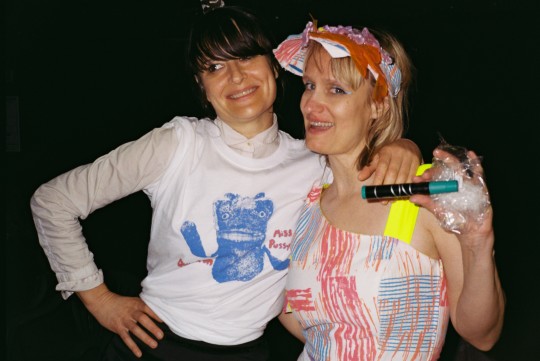
This joyous display of unbounded creativity left me with that warm fuzzy feeling you get when you encounter the rare kind of beautiful dreamers that still exist. They create that fascinating blend of genres that leaves them impossible to pin down. The term most often used to describe their sound is swamp-tech. While that might sound quite reductive, it captures their Mississippi weirdness and dance floor roots nicely.
They sure were the discovery of the festival for me; I still can't help smiling thinking about their show.
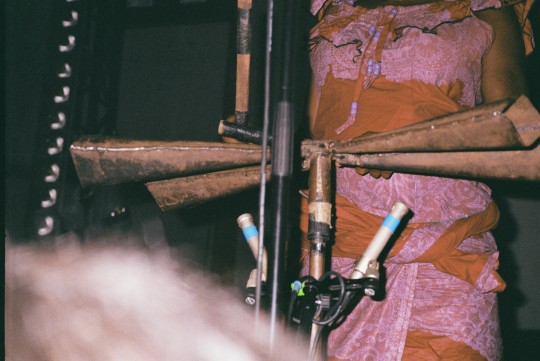
Now those white kids need to watch and learn!
We all knew Saturday was the last big night of the festival; the exhaustion was seeping into the stage crew, but everyone soldiered on, excited about the most anticipated act of the evening – Konono No1!
After a long evening of dance teasing, it was finally THE moment we've all been waiting for; it almost felt like this is what the entire festival has been steadily preparing us for, taking us through a dark, emotional journey only to reward us with exuberant Congo drums for our patience. The entire date was planned as the ''fun night'' of the festival, although the real fun only began about halfway through Quintron's set.
I took another swig of whiskey and headed to secure my front row position before the band got onstage. Unlike the other interludes, many others have taken the same precaution. I could spot them from the backstage, waiting to make their entrance. A group of people that looked completely ordinary, much like the type you would see on your commute on line 13 or near my friend's house in Saint Denis. This sort of average appearance rendered them strangely relate-able. After all, those were the Congo superstars, THE group who toured the world and played with everyone who's anyone. Like many other teenagers, I discovered their music quite late, spotting them among Bjork's collaborators in 2007, a time when The Ex did not have a meaning for me yet. I may have seen a few of them on stage with her during that tour. Maybe on my first trip to Paris for her set at Rock en Seine? Or maybe not, since I recall being bummed they didn't open for her at that show we drove 12 hours to in Istanbul.
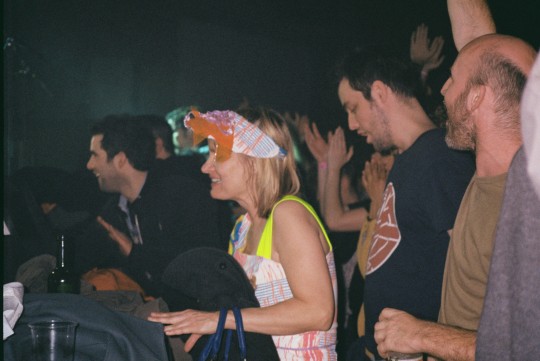
Something had come full circle in this musical journey and now the show was about to begin. The audience exploded as they went on stage, cheering and applauding with a very non-characteristic enthusiasm. Maybe it was Quintron's warm up; or just the sheer uncontrollable joy in anticipation of what was yet to come. The show was sold out.
The group started with the leader, Augustin Makuntima Mawangu, slightly nervous, greeting us in French with a full smiling face. He's probably still adjusting to his new position, since his father, the founder of the group, passed away merely a year before. Everyone was in position, waiting for his signal.
Then Pauline Mbuka Nsiala, the lady of the group, started working what looked like an art brut interpretation of a cowbell cluster and the ceremony began.
I can't quite describe what happened after; it's very hazy, lost between the arms and legs of fellow dancers intertwined, avoiding bears and piling on the coats of the newcomers, trying to move closer to the action. It spread like wildfire, leaving no survivors in sight. Within ten minutes, everyone and I mean everyone was dancing.
Twenty, five and forty-year-olds alike were taking the syncopated beat all in, often in spite of their bodies; it was as if they couldn't resist the urge for dancing but their members somewhat still had to catch up. They were out of sync, not really knowing how to move their arms and legs properly. They were jumping, swaying, raising their arms up in the air, or desperately trying to fit their club moves into the 140bpm orgy. Yet they were all dancing, dancing with the glorious abandon white people rarely get unless they're heavily intoxicated. They were beautiful in their awkwardness. And probably it would have felt less out of place if you didn't spot the few black dancers in the audience who seemed to know exactly how to move to this music. Not with their hands or legs in desperate agitation, but with full control and grace, letting the hips and torso move seamlessly.
But nobody was really paying attention to them; Pauline was stealing the show on stage, exhibiting the authentic way of dancing which had magically un-dislocated hip written all over it.
I was probably the only one looking at the other dancers, feeling uncomfortable in my white girl lack of coordination.
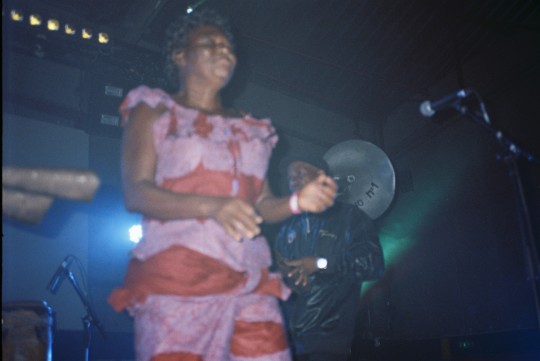
Yet nobody seemed to care, entranced by the music, continuing to move, shout and sway, hypnotized.
Even that stuffy guy who ruins the show by posting himself up front, in primo dance territory with an annoyingly big zoom lens felt like he needed to pay his dues to the dance god and was lightly swaying while swapping cameras.
Augustin talked for another couple of couple of minutes, telling the audience how they have traveled the world and have seen so many incredible places on their journey and they were headed to Florida next, before introducing they new tune, Kuna America, from their collaboration with Batida.
The result was not much different from the rest of their repertoire, the brief intermission soon melting back into the drums/bells/whistles/likembé vortex sweeping everyone off their feet.
I left my suffocating spot to get a better look at the crowd; the dancing was endemic. It was pure joy to see the staff members coming over the fence, happily celebrating this last effort with a frenetic dance. From the bar to the backstage, the large industrial hall was still trembling after a solid dance marathon clocking towards a full hour by now. If you looked closely, you could almost see the sparks in the air.
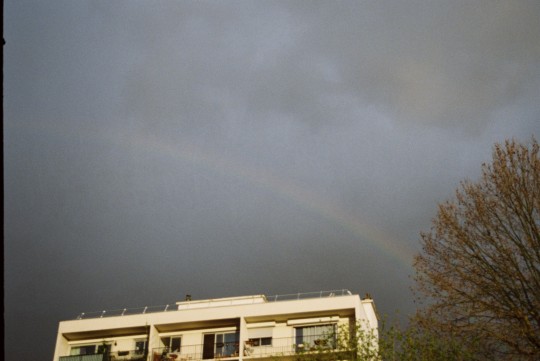
Stormy weather
The next couple of days were a blur; it might have something to do with my Montreuil night bus misadventure that can only happen if your head is still full of music and your feet barely hold up after all the dancing.
And, since Paris is the cruel cultural clusterfuck we all love and hate, my quiet Sunday with a short show scheduled turned into an evening interview with my fellow Beaux Arts alumni who took RadioBAL to the electonic art festival in Creteil and my new RA friends invited me to Concrete for their Residency party series with Move D and Margaret Dygas. And I love me some Dygas!
Not that it would have any direct connection with the festival, but it just goes to show that a trip to Paris for one event is never just that, as there are probably 3 or 4 equally interesting art/music-related happenings going on at the same time, often fighting to reach the same audience.
Monday I finally went to see the Re:Cycle art show associated with the festival, although Nicolas Collin's charming conference made more of an impact. I don't think I've seen an artist present his work with such poise and humor. Watching footage of performances from his generative scores, it felt like he could have been better integrated into the program as a composer, not just through his workshop and art piece. I really hope I'll get to meet this master again.
My Tuesday plans fell through, when rushing to get to Grand Action, one of those repertoire cinemas in rue des Ecoles I used to love frequenting as a student, I saw a large fire truck blocking my path. A group of people were outside the theater. Oh no. The red truck was, unfortunately, linked to the festival – an overheated projector caused a small fire in the cinema. Nobody was injured, but the screening had to be moved. Cecile, the PR, was handling the crowd with a brave, nonchalant smile, jokingly suggesting that the theater caught fire because they were too hot.
The found footage film, 24 Hour City by People Like Us was moved to an improvised screening room within the exhibition space in La Generale, two hours later. I was impressed by their diligence, but my sleep deprived self could have not endured another nightly adventure and my 6 am flight.
I said goodbye with a heavy heart, crossing the bridge towards the 85 to a beautifully-timed sunset, Eiffel Tower, the works... It was the Paris carte postale in all its glory; the perfect credit-rolling ending to this beautiful festival. I was sure hoping to return the following year.
Waiting for the bus with a friendly looking bearded clochard, I played again the lyrics that have been on repeat in my head all through this journey: ''Keeps rainin' / Don't know why it keep on rainin' , to Viola Wills' melodrama disco tune.
0 notes
Text
Tajik Folk, Almond-flavored Vodka and Iranian Techno
for The Attic Magazine
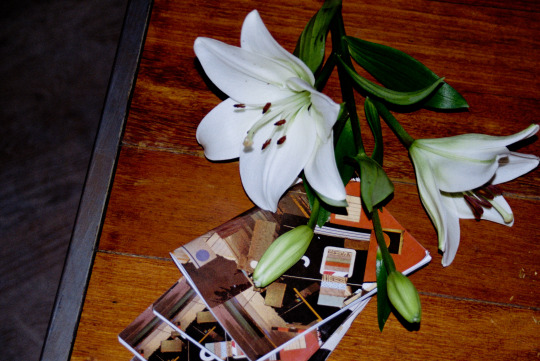
Writing about your first Unsound is a particularly difficult challenge, given the overwhelming, all-encompassing nature of the festival; not to mention the drunken, pierogi-infused haze that filters the entire experience, as a friend put it. Many people rave about Unsound and flee to Krakow with cult-like devotion, and rightfully so.
What makes the festival so special is its unique way of finding a balance between the entertaining and the adventurous, the academia and the dancefloor, the old and the new, the experimental and the club, house and techno… The list of dichotomies can go on. In short, Unsound manages to provide something for everyone, in the best way possible.
Outside a Saturday show at the ICE congress center, we were joking with a couple of girls from the team that the only critique we have about the festival is that the schedule doesn’t accommodate time for lunch of dinner, as one would like to see everything. They said that was the exact point - people who come to Unsound are curious music explorers, always hungry for more, but who also know how to get down on karaoke night.
It is a wonderful glimpse into a potential future of inclusiveness, curiosity and music as a breeding ground for ideas and exchange. Did I mention it also takes place in a superb, medium-sized, shockingly affordable (even by Romanian standards) city?

What also contributes to the general exhausted-ecstatic vibe of the punters (besides the comforting nature of Polish cuisine) is the universal quality of the sound; I know, complaining about the sound is the go-to noob move, but basic psychoacoustics say that when the sound quality is bad, no matter how good/comforting the music is, it will put us in a bad mood. For this, Unsound engineers deserve a star-studded gold medal, as everything and I mean everything from Manggha, the Japanese art museum, to the old tobacco factory or communist ballrooms of Hotel Forum, sounded great.
It was mind-bogging to the point that acts I had seen in other contexts recently and didn’t impress me much went through a complete metamorphosis through these sonic lens.
Given all those elements, it is quite hard to pull yourself out of the festival stupor and try to have a level-headed opinion. It is one of the most intoxicatingly addictive yet intellectual festival experiences.
Without elaborating on the hellish arrival I had to endure, once in Krakow, after an all-night bus ride from Berlin a day later than planned, I finally managed to squeeze in a power nap in my monastically sparse Airbnb room and head over to the press office.
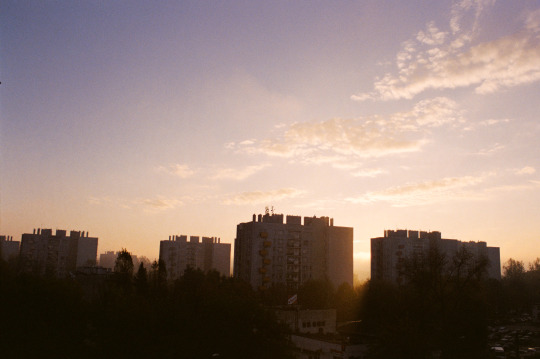
Unlike ADE, taking place during the same weekend and completely takes over every bit of Amsterdam, with the enthusiastic support of the mayor, Unsound is a rather discreet, disruptive presence in the scenic city of Krakow - more of a secret society you might hear about but not really know where to find.
Although they are both key industry events, it would be rather inappropriate to compare the two.
During Unsound, the city does seem to carry on with its flow of students, tourists and people going about their daily business, while flocks of English-speakers with a proclivity for black stare at tiny earth-toned booklets, in search for directions. Whenever getting lost in the intricate maze of hidden venues, approaching one of them usually helps. This unspoken uniform has even become an ongoing joke.
This is actually all it took for my lost, frustrated and yelling-Romanian-insults- under-my-breath self to turn into vodka-slinging, pierogi-fed happy punter. Because, as soon as I asked the group of three ladies for directions (who turned out to be the PR team of the festival) and step foot into the little oasis over at Palac Krzystofory, my life has inevitably changed.
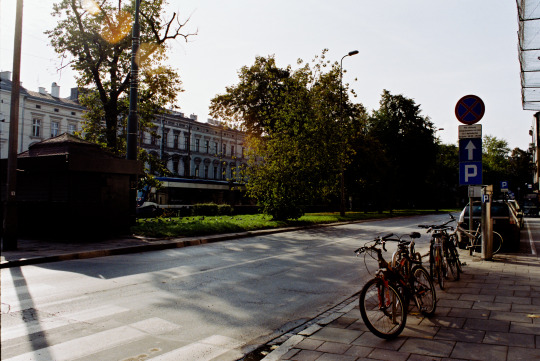
The Dislocation theme couldn’t have been any more appropriate for the pan-global yet family-like vibe of the festival. Ten minutes in, I had received my yellow bracelet, the magic amulet that would get me in to all the events, a friendly name tag and had bumped into a British friend from Paris, who was doing his 6thUnsound with a jolly group of friends.
This first night is still a blur of almond-flavored vodka, Doliprane, pizza and a lot of faces, faces, faces. We’re finally at Manggha. It is dark. The first act just finished playing. I try to get closer to the stage. Alan Bishop, Maurice Louca, and Sam Shalabi are getting ready to start. Although I had seen the trio play recently, what occurred was as if the Dwarfs of East Agouza had been bitten by a radioactive bug and their sound had gained superhero powers. I spot Max Eilbacher’s silhouette near the front row. We hug. He joins Drew Daniel and Britton Powell, his Perfect Lives squad. We hear a loud, thunderous base erupt. The low-rise stage is impossible to see from where we stand, but the music penetrates through every fiber of our beings. The boys start head banging. Sote’s live techno act is incisive and merciless, in a good way. It’s funny to think that the best new techno is infused by Persian poetics, given that Voiski’s origins also lead back to Iran…
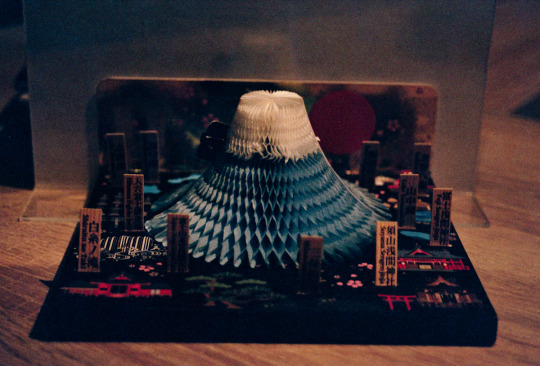
The next morning, feeling human again, I rush to J. Francois Bonnet’s highly interesting talk about listening. The Presences Electronique curator’s lecture is followed by the moment we’ve all been waiting for – the Matmos panel on Robert Ashley, moderated by Philip Sherbourne. The talk is even more delightful than the sum of their interviews and Drew’s twitter feed combined, blending the entertaining and the informative with grace and levity. One has to ask – is MC Schmidt a closeted stand up comedian?
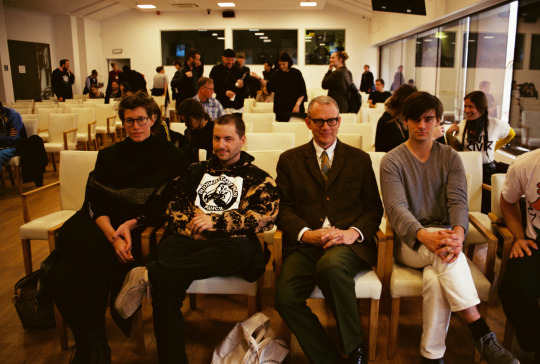
A couple of goulash-drenched latkas and beet soup later, we’re back at the Manggha stage, just in time for the commissioned collaboration between traditional Tajik trio Samo and Polish Stara Rzeka with his delicate guitar sonic filigrees. Samo’s music is of a primitive, overwhelming savage beauty, despite the constant feedbacking from the microphone cluster around their handmade instruments. Rzeka’s counterpoints are rather restrained, but add gentle textures to the heartbreaking mountain ballads.
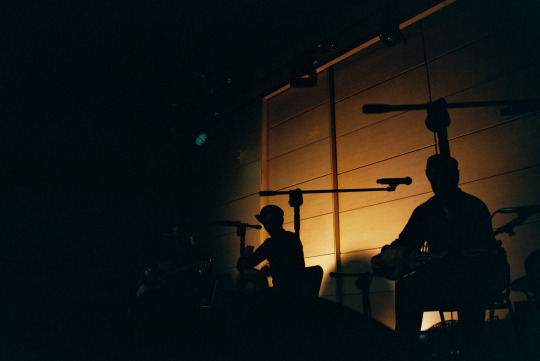
Still sweating out the last drops of last night’s karaoke-induced tequila excess, I melt into one of the comfortable upstairs seats of the packed ICE center. Prismatic amoebic creatures appear on the large screen, bringing the Alva Noto-scored plankton video I saw at Fondation Cartier and Jodie Mack’s films to mind… Deep, microtonal drones wrap me in a warm blanket of baselines. Ghostly vocals are masterfully peering through the electronics. It is Kaitlyn Aurelia Smith orchestrating this entire modern pagan ritual.
The Rashad Becker hype doesn’t really click with me; I choose to hang with the Robert Ashley gang in the hallway instead. Martin is talking about having a drink on stage, however, not in a fluted plastic glass.
We take advantage of the now-empty room to get our spots right up front for Horse Lords. I snap Drew eating a Rom bar. The four-piece Baltimore ensemble takes to the stage dressed in chinos and tucked in shirts; once they start playing, the nerdy vibes turns into a devastatingly dancey math-North-African jazz, sounding incredibly fresh.
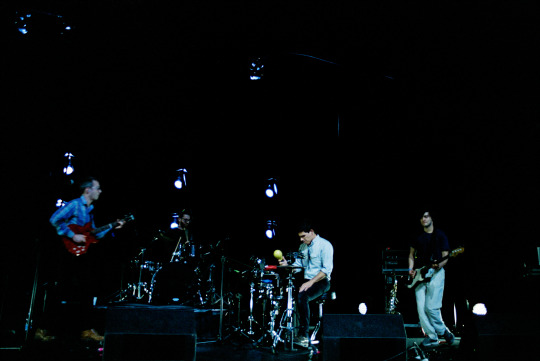
We are now good and ready for the after party at the newly-opened Kitchen, the former cooking facilities of the communist relic Hotel Forum, traditionally hosting the weekend parties. After a lengthy warm up in the chic bar, we finally head to the floor. Nobody could have ever anticipated the mix of raw energy, unpolished setting and nostalgia-driven yet futuristic sounding music that made Wednesday night perhaps the wildest party of the festival.
Right as NAAFI founder Mexican Jihad was finishing his set, Berlin’s Mobilegirl continued the ’90s Eurodance-sampled alien bass fantasy with extra chutzpah. By the time Lao took to the booth, the bodies drenched in sweat in the foggy, strobe-lit space entered a collective music-induced acid trip, cheering to the choruses of What is Love or Madonna’s Music, cultural detritus from our MTV childhoods.
The following day, back at the Krzystofory, we were all congratulating Lukas Warna-Wieslawki for curating the party. Someone else expressed what we were all thinking – „normally I would so hate that kind of music, but oh god last night was amazing!”.
Hearing NAAFI’s talk the day after the party, things took a completely different meaning – what we had taken as millennials’ obsession with the ‘90s and the skeletons of PC music had actually a profoundly local, political edge. The Mexican story of Eurodance hits dominating dancefloors and popular culture until the mid-aughts sounds strangely familiar for an Eastern European. The ubiquity of Ace of Base, Coco Jumbo (which became slang for jocks in Romania) or Mr Vain in the extra-American space speaks volumes on marginalized cultures. What NAAFI emphasized was their effort to be local and reference their history rather than Internet fads, using samples as musical postcards from the past.
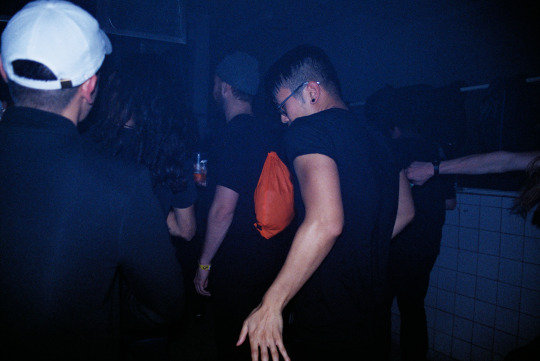
Finally, the highly anticipated Robert Ashley moment arrived. The 800-seat Kijow Centrum cinema was filled to the brim, surpasing everyone’s expectations.
Their take on Perfect Lives was both respectful and ingenious, bringing some original interpretations to the libretto, as well as preserving its spirit. The addition of vocalists Caroline Marcantoni and Jennifer Kirby as the Greek choir was a very inspired move, their hypnotic repetition of phrases creating a trance-like state. My favorite was perhaps The Backyard, which, since the 2013 Presences Electronique performance, has evolved into a transcendental dance piece with Drew’s sublime use of electronics and Martin’s delightful cadence.
The first real night at Hotel Forum was as decadent as anticipated, with sensual techno flowing from the big room; while an unexpected selection of footwork artists were wreaking havoc in Room 2. I arrived just in time for the excellent Senyawa / Rabih Beani collaboration, while rushing to catch a glimpse of Foodman’s set, which proved to be even weirder than his 3hd piece, however inconceivable that may sound.
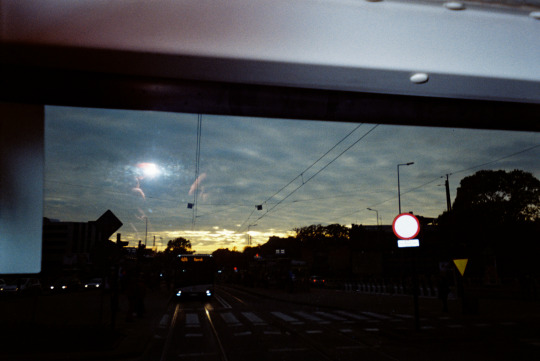
The real highlight of the night was the unexpected DJ Fulltono / Traxxman duo, a trans-Atlantic premiere collaboration united under the Teklife flag. Their lightning-paced dirty house music was the perfect party lubricant everyone’s been waiting for.
By the time DJ Earl took to the stage, together with a crew of footwork dancers, the crowd went into full abandon mode, discovering new moves on the dancefloor while samples of Kym Mazelle and Tronco Traxx brought an ecstatic smile to all our faces.
If Thursday night felt excessive, Friday seemed almost impossible to grasp, given the three-room formula. I did stay through the Uruguayan F5 live premiere (bonus points for IRL drumming), a particularly eloquent example of locally-flavored dance music, while trying to find my place within fractures of Demdike Stare’s dark forces, Faka’s energetic live and DJ Lag’s rather disappointing efforts in Room 3.
The highlight came in the shape of Acid grandparents Phuture who, despite the recent loss of DJ Spank-Spank, saw DJ Pierre perform a tantalizing set alongside Angel Alanis.
One of the most entrancing Unsound moments came from Kablam - playing the 5am slot in Room 2, bathed in blue and magenta lights, she delivered a maze of RnB remixes, Tangerine Dream-like interludes and rave moments. Staring at the dancefloor filled with queer millennials in ‘90s gear, the entire setting felt like a scene from an early Gregg Araki movie.
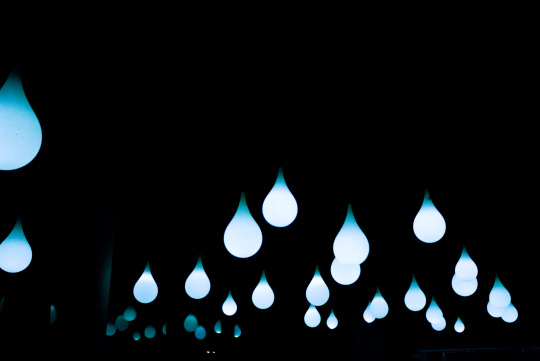
Denmark’s Apeiron Crew female trio continued to fuel the girl-power trip instigated by Kablam with edgy big room sound. „Who rules the world? Girls.”
Wind Tunnel was a more-than –appropriate name for this shape-shifting night.
Saturday, the last major party at the Forum, embodied that moment when a well tuned machine goes off course – everything felt like too big and too much, lacking the coherence of previous parties. This baroque excess was first expressed with the first familiar chords from Forest Swords, drifting into Soichi Terada’s infectious smile and happy house tunes, dipping further into the deep end with JD Twitch’s Muslimgauze set.
Africaine 808 and Dodo Nikishi’s live performance was a highly entertaining set, proving once again the almighty power of live drums.
Overcoming physical and technical difficulties, master Anthony ‘Shake; Shakir delivered the ultimate veteran schooling set, making the crowd go wild over fucking Radiohead. Via App shared some fresh house, Yves Tumor showcased the first crowd surfing episode of the festival, while Kamixlo was too high to mix his own tracks…
Further in the night, Fred P performed a deep house healing ritual in the big room, followed by a maximum energy b2b by Polish Olivia and Kazakhstan DJ Nazira. I was already hooked after their NTS live set and seeing them work a proper room was a real treat.

The Sunday burnout was quite brutal; everyone was equally tired, sentimental and sniffly, especially with what was now caleed the Unsound virus.
Kara-Lis Coverdale’s Philharmonic performance was the perfect over-the-top, majestic display of drones we were all craving. On top of a white-lilies-covered stage, drenched in digital geometric stained glass motifs by German artist MFO, she was our goddess for the evening, ensuring a safe passage back into the real world.
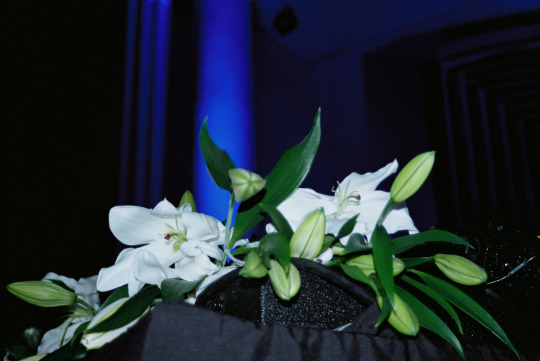
Coming back to these lines on election morning, when the frightening prospect of a Donald Trump presidency is putting a rather apocalyptic damper on things, I am more amazed than ever that I have taken part in this inclusive, pan-global sonic utopia.
Force-listening to Lou Harrison on this wet November morning before work, I’m trying to muster my strength and finish this text, as, in the sobering light of potential planetary chaos, it is crucial to remember, preserve and promote such positive experiences. Those confusing times render the entire experience all the more special.
It is festivals like this that make the real political statement.
0 notes
Text
A Lesson in Listening
for The Attic Magazine
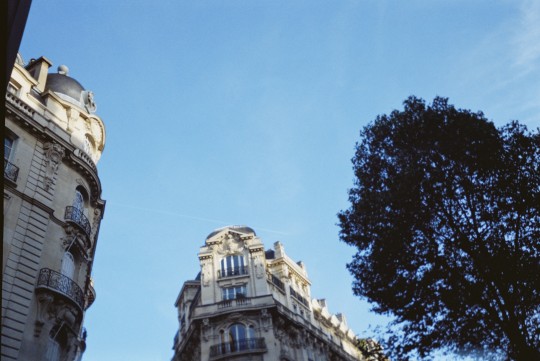
Paris is a place brimming with culture, where every form of art imaginable, however niche, can find a healthy following, be it experimental film, clowning or noise music.
And there’s no better time to observe this than during la rentrée, which is probably the craziest time of the year. Just try to picture each theater, cinema, museum or other type of cultural institution starting to steadily bombard everyone with offers or entertainment and knowledge.
Among the more popular and visible events, drowned in the monolithic presence of Festival D’Automne, a small festival shines through like a hidden gem – it’s L’Audible, a yearly inter-disciplinary experience dedicated to the shape-shifting landscape of experimental music.
Co-curated by les Instants Chavirés and Jérôme Noetinger, the festival focuses on what the French call musique électroacoustique. Originally a term coined by the GRM, it’s now being used to designate all forms of experimental music using recorded material for modern composition, musique concrète, EAI, field recording, sound art and even noise.
If Sonic Protest is the more playful rock/dance/big room avatar of les Instants hors les murs, L’Audible focuses on the quieter, academic part of the experimental spectrum - it’s the older, grown up sibling.
It’s quite a discreet affair of roughly 150-200 people, happening in the somewhat hidden Théâtre L’Échangeur at Bagnolet, an Eastern suburb neighboring the mythical Montreuil.
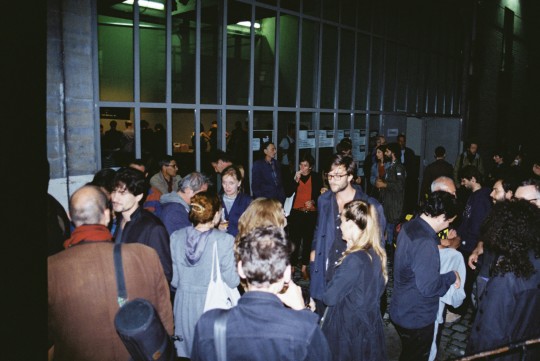
Caught in the murky mid-September slumber, it’s been a festival I somehow always missed for various reasons. L’Audible started out in 2011, focusing mostly on listening sessions and composer showcases, with a couple of live acts. It was Thierry Schaeffer, the director of Les Instants who approached Jérôme Noetinger, a prominent figure in the French underground and boss of label/distro Metamkine, to curate a festival focusing on electroacoustic music. The main idea was to find a slightly bigger space, which would allow them to host a multi-speaker system and to present a large panel of electroacoustic music from pure musique concrète to live performances.
It now grew into a three-day multimedia extravaganza, including concerts, conferences, experimental film screenings and sound installations.
Given the neighborhood’s questionable reputation, it’s quite impressive to see this little courtyard near Gallieni and turned into a cultural hub. Most importantly, this metro stop is famous for an abundance of weed dealers and stolen phones.
In many respects, this sort of event could only be possible in a place like Paris, where state funding, combined with a healthy public outreach from cultural institutions leads to highly educated audiences and a buoyant music climate.
One has to remember that Pars is, after all, the place where you can go to any cinema (except for the trashy UGCs) and see the audience sit through the credits. They take their 7-year-olds to the Pompidou, have philosophy classes at the age of 4 and a contemporary art center in every suburb. This also breads saturation and might render a lot of people chronically jaded, but it’s still quite impressive.
It is very improbable that anywhere else on this planet you would have an average-looking septuagenarian coming to complain to the organizers after a painfully long performance, that a certain audience member has been whispering during the show. “This is musique electroacoustique, sir!”
People here are trained to sit in silence and listen to particularly difficult music with a certain sense of pride.
In the courtyard of L’Échangeur, during the weekend of the 16th, an enclave dedicated to attentive listening was formed – the venue hosted a concert hall, with records stands from Metamkine, a wine bar/bistro right across and the small building for La Lutherie Urbaine, an organization dedicated to building/performing with DIY instruments.
The festival felt like a mix between an extended family reunion and a peer review; a large number of the audience was other musicians and composers rather than just regulars. The local celebrity spotting included Sophie Agnel, Ignatz Schick and Erik Minkinnen, to name just a few.
I actually ran into Ignatz in Berlin three weeks later, at a completely different festival, and he shared a story of Jac Berrocal hitting on Felix Kubin during the first night..
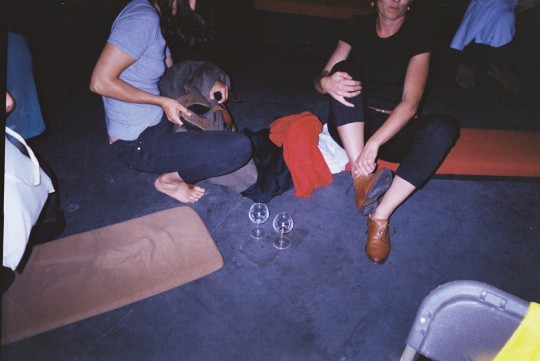
Perhaps the most impressing was Aaron Dilloway, the big noise star of Wolf Eyes and Hanson Records fame, sitting quietly in the front row at every single performance.
After the better part of three full days spent at the festival, the most poignant words that come to mind would be darkness, silence and stories.
Apart from the screenings and sound installation, the festival was a highly non-visual experience.
Jérôme Noetinger acted as master of ceremony through the festival, taking the time to give little speeches and introduce every performance. It wasn’t particularly formal, but rather awkwardly informal.
The best part was during the first night, when he asked the first two performers, Felix Kubin and Jana Winderen, to introduce their pieces.
Visibly uncomfortable, Kubin began his story in his signature German accent – what followed was both instructive and endearing. He told us about Max Brand, a sort of mad genius music maker, who began developing his own synthesizer, in collaboration with Robert Moog.
Only his ideas were quite extravagant and, as they started growing more and more elaborate, he had used up all his funding and Moog was forced to even pay his own traveling expenses.
Because of this, they only built one unit of the aforementioned machine.
He recalled how, during a residency in a monastery, he started using this synthesizer, which was located in a room hosting an exhibition of Moog and Brand’s correspondence. The machine seemed to take on a life of its own, slowly going out of tune as soon as it would turn on, with its many oscillators creating strange patterns and harmonies. The result oscillated between organ-like sounds and heavy, punchy tones.
He would spend hours alone with it, simply turning it on and listening to its glitches, while walking around the room and reading their letters. He felt a certain unease, as if their spirit was still in the room.
This discreet ghost story embellished the solemn and aggressive dark tones with an extra layer of ectoplasm. As a result, the spars, modern techno piece, routed through the 8-speaker acousmonium, had a particularly spectral feeling.
I believe his story managed to transform the already intense piece into a very engaging audition. After seeing his more dance-y performance in 2011, as well as a playful, voice-oriented endeavor in 2013, it was refreshing to catch a glimpse of another side of this fascinating German space dandy.
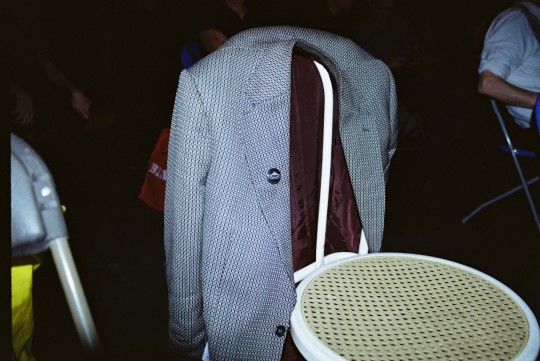
One cold November evening, getting out of the traditional Wednesday night experimental screening at the Pompidou, we were poking fun at a friend who dozed off during the screening. Kitty, the filmmaker friend who invited us, was arguing that, actually, that was the best way to experience this sort of movie, in the fragile state between dream and awake.
My long voyage sure took its toll and, during his mesmerizing set, I was constantly drifting in and out of consciousness, which gave the experience a very intense, hallucinatory feel.
But the best part was still yet to come. I’ve been familiar with Jana Winderen’s work since Heated, her 2009 EP, topped end-of-the-year lists of music bloggers. It was quite striking to finally see her in person.
As I arrived some 4 minutes before the first concert that night, the room was a compact group of chairs, facing one of the walls. After Felix’s piece, instead of an intermission Jerome turned to the audience and asked them to rotate their chairs in a circle formation. This brief piece of collective performance art had surprising effects, breaking the dense mass into more recognizable pieces; people were finally finding friends or discovering new companions.
In this whole process, I ended up seating next to Felix himself.
Jana quickly began her introduction; she started by calling out the obvious awkwardness of the situation, as for her, being surrounded by people was a strange position, being used to always working by herself. As a biologist, she studied the movement of plankton and other microorganisms, as well as the effects of global warming. Her research took her to Antarctica, where she was surprised to find many broken, insular ice pieces instead of the regular massive blocks.
She talked about the variety of sounds she’s been recording, from water in various states to insects, wind and animals.
“It starts with ice and it ends with this mustachioed sea lion I came across”, she said.
However prosaic, her explanations may have deepened the mystery, for what followed sounded even less grounded in reality than Kubin’s ghosts.
Textures and field recordings are well-established terms in the experimental music vocabulary, but what Jana shared sounded more like the pure construct of a febrile imagination rather than a series of careful observations of the world around us.
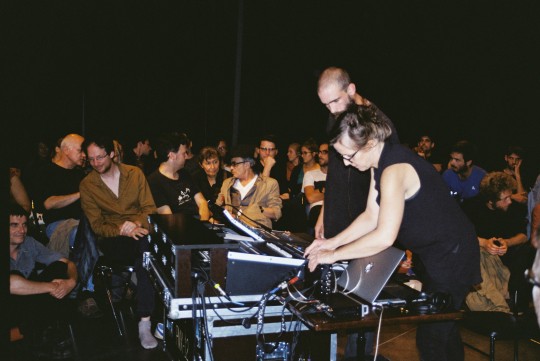
While her sounds did seem somewhat familiar, there was something profoundly outlandish in her curatorial choices and delivery, a special sort of sensitivity that rendered them unique.
Her insects were not as noisy and literal as Dave Philips’, but rather airy and smooth; hers wasn’t the analytical editing of Chris Watson, but a sort of warm, earthy type of world building.
And, at one, point, this incredible howl, impossible to place, started pouring down from the speakers, resonating through the space. I don’t know how many people remembered the sea lion from the story, but this sound was terrifyingly alien and achingly human.
I remember reading that many Foley artists use the scream of the sea lion, especially in horror movies.
By the time the lights went back on, we were still haunted by this mysterious howling. It was probably my favorite piece of the festival.
The next day, the effect of the Parisian drizzle translated into a fever that appeared like clockwork and made me miss the afternoon 16mm experimental film screening and listening session.
It was, however, a sensible choice, as the following night was quite dense, with four performances that went on well into the night, or just barely enough in time for the very last Saturday metro.
Jérôme hosted the evening by himself this time around; I somewhat missed the awkwardly endearing introductions by the artists.
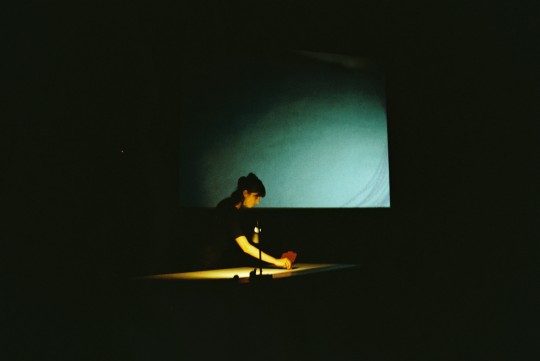
The evening had a slow start; Barbara Ellison’s first series of phantoms were rather unfocused, but as soon as her live performance began, the atmosphere changed completely. A video camera was facing a large table with a piece of paper on it. After a long silence, a lady, dressed in black, approaches the table, takes out a crayon and starts drawing circles on the surface. Her circular motions, amplified by a contact mic, slowly become more and more textured, evolving into a mesmerizing series of drones, going stronger in intensity, as the paper turns into a perfect piece of abstract expressionism.
This sparse, strikingly simple setup led to a dense, ritualistic music. It was the perfect art school graduate sound piece – it had a performative element, a physical trace and something to hang in the gallery at the end.
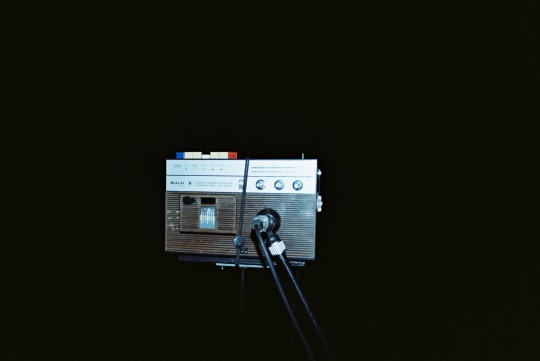
Among the many changing seating arrangements for each piece, some of them quite gratuitous, I very much enjoyed Angelica Castello’s take to the space. For her tape piece, she placed amped up cassette players in a circle around the room. It was one of the few visual pieces, showcasing the beauty of obsolete technology, from chunky Dictaphones to that double-deck Philips stereo we all probably had back in the ‘90s.
The 8 tapes played looped vocals, various textures and instruments, creating a highly dynamic, delicate piece.
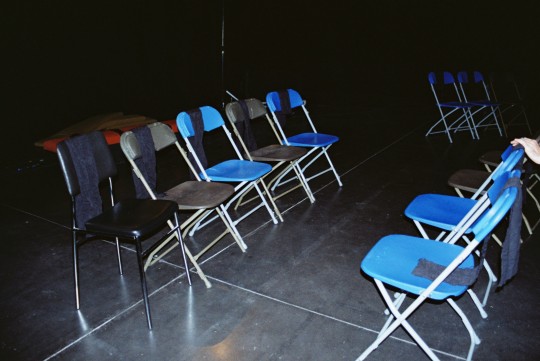
By the end of the evening, Francisco Lopez welcomed us to the most striking seating arrangement. I’ve seen him perform back in 2011, at probably my first edition of Présences électronique, and was expecting his signature blindfolds. That Saturday, he played the first or second afternoon slot in the small auditorium; after his set, everyone started using the blindfolds for the rest of the day. It was as if they’ve finally been given permission to close their eyes and fully take in the music. It was quite beautiful.
Only this time, he demanded that the chair circle would have people facing each other, creating a new sort of spontaneous intimacy. I took my place on one of the floor cushions, awaiting his soothing collages. He urged us not to take off the blindfolds, no matter what.
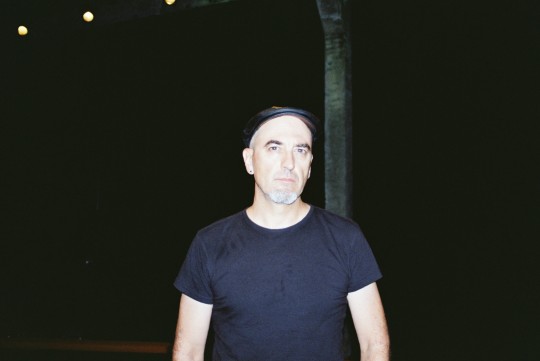
I have to admit to have cheated during the show, and, to my surprise, I caught a glimpse of him frantically pointing a flashlight in circles towards the crowd. I couldn’t perceive anything different while blindfolded, but there was probably some physical effect to his invisible light show.
As the last of his reverbs slowly died down, the room was vibrating with the sizzling sound of someone snoring. One could say that this was living proof that, whatever form of hypnotism he attempted, was working.
On Sunday afternoon, the long awaited sunshine finally made its way back into the grey capital.
I attended a performative debate between Rudy Decelière and Bastien Gallet, a sort of Youtube party between two best friends, only with field recording and philosophy instead of videos.
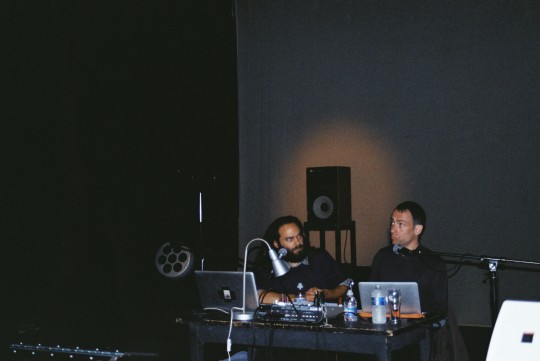
I hadn’t seen Rudy’s installation yet, but this experience had me intrigued.
Stepping into the small building of La Lutherie Urbaine, tucked away in the left corner of the yard, i was welcomed by shushing and a strange feeling of walking into a forbidden area. Perhaps the same feeling you get when you arrive in a quiet space and even your breath sounds too loud, no matter what you do. At the end of a narrow hallway filled with gorgeous DIY instruments, now sitting silently, followed Jour par jour, perhaps the most quiet sound installation imaginable.
There was a rare beauty in its organic simplicity : hanging from the ceiling from long, copper wires, dried magnolia leaves were slowly rotating, scratching the floor, guided by tiny magnets that resembled robot Aspirin. It made Julius Rolf sound like EDM.

The sun was finally setting and the very hyped last evening fast approaching.
After a gutsy tape set from Italian duo Lettera 22, it was finally time for Aaron Dilloway, the big star of the festival.
The theater brought out the bleachers, which filled up within minutes. There were people on the stairs and on the floor, waiting patiently with a glimmer in their eyes.
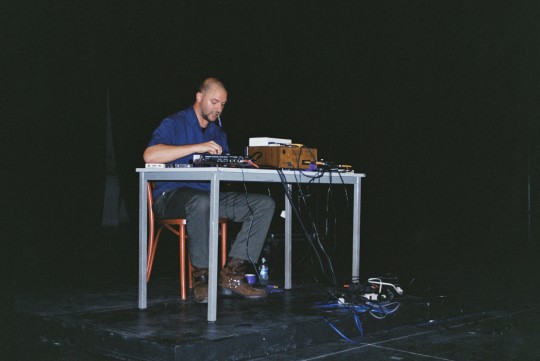
In the middle of the stage, at a small table, Aaron was sitting in front of a gear cluster. He slowly started off the show by dragging his heavy boots on the floor, creating acoustic loops witch circular motions. Moments after, the chaos began – tapes were destroyed, a contact mic was hanging from his mouth, screaming, panting and turning his machines louder.
The performance grew more and more visceral, to the point that his pain became unbearable. The 20-odd minute set was a polarizing moment of dark catharsis.
By the end, despite its sonic virtuosity, the entire experience felt deeply personal, almost too intense, to point of being uncomfortable.
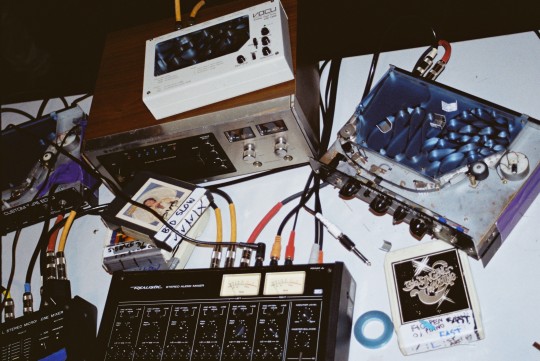
The little table remained in the middle of the stage, deserted, broken tapes and other technological debris lying on the floor like a gutted animal.
It was a very stark contrast to the more buttoned-up endeavors from the previous evenings. Although it might read as intentionally provocative, there was something undeniably real and emotional in his piece.
The act of active listening changes your view of the world; it makes you a little more aware, slightly more sensitive, and more connected to the world.
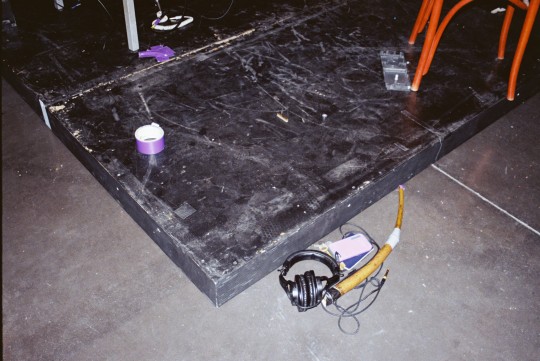
It’s those moments when you stop focusing on creating a detached space around yourself during your busy day, burying your face in your phone screen and become attuned to the brief glimpses of beauty around you. It may be that tiny Algerian grandpa that looks like he came back from the ‘70s smiling at you at the grocery store, or that middle-aged woman watching Celine Dion videos in the back row of the 95 bus, or that red-leaved plant called la misère...
Naturally, one cannot picture the sheer existence of a festival like L’Audible without Presences Electronique, the GRM effort coordinated by Cristian Zanessi. While Presences is more of a blockbuster, with hundreds of people attending, mind-boggling sound systems and free admission, L’Audible is the film d’auteur.
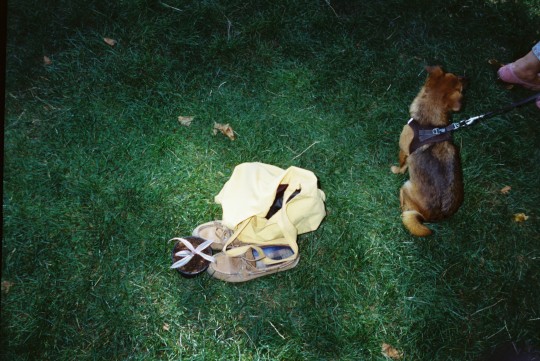
However, the two coexist and even collaborate : ‘’ I think Audible and Présences électronique are working in the same field but with some different directions. We also did a collaboration with a mix commission to Lasse Marhaug and we hope to do this again soon.’’, said Jérôme.
Despite its modest scale, L’Audible has grown into a compelling little festival; there are certainly still a lot of things to be improved and their seating gimmicks do not compensate for a more complex sound system, but whatever direction they choose to take, they should maintain their intimate presentation of well-curated propositions.
While I’m still kicking myself for missing Michel Chion’s Sunday morning piece, I do console myself with the story that Rudy told us.
During a residency in Morocco, he was passing through the bazaar, recorder in hand; it was one of those rare days when everything seems to fall into place – a windless afternoon when each sound was telling a story, coming together in a highly cinematic way, as if someone had been conducting it. He was moving cautiously, trying to make as little noise as possible, thinking about how unique and incredible that moment was.
When he finally arrived at the end of the bazaar, after this intense period concentration he gave out a deep exhale, and, relieved, reached to turn off the recorder.
He suddenly noticed that the machine was not even on in the first place…
L’Audible festival took place in Paris, September 16th-18th
all photos by feral noise
#reviews#the attic#instants chavires#l'audible#jerome noetinger#felix kubin#jana winderen#aaron dilloway#francisco lopez
0 notes
Text
Mort Garson - Mother Earth's Plantasia
for The Attic Magazine

4 / 5
Label Homewood Records
Released 1976
Published July 20, 2015
Touring and DJing can be extremely tiresome activities. That's why I'm trying to compile a series of records for those moments when DJs are trying to lead 'normal lives'- you know, like sleeping at night, making love or growing plants.
I've had a lot of plant talk lately; it may have something to do with my hanging out with Chlorys so much lately and sharing photos from international botanical gardens or swooning over succulents.
'I know you don't have time to talk to your plants, so I'm going to talk to them for you. You can go on about your business whether that's going to class, or the office, or fixing dinner, or making love. Don't worry, they'll listen to me. Let's begin.''
Molly Roth - Plant Talk
I do know that my friend Luc always makes time to talk to his plants when he's not touring. I have also met a girl in Berlin who had little name tags for all her house plants.
So yeah, plants were on my mind.
As far as coincidences and planet alignment goes, I had a very pleasant surprise when I received an email from my friend Markus from DIY Church about his next radio show - the title read Nu World Music - Ecogoths in Nu Plantasia and features a gif of a 70s hunk's crotch unzipping his pants to pull out a pink daisy. This coming from a guy making techno-noise live collages.
Charmed!
I don't know if Markus was eating salad to stay on theme with the show, however I do know I've been pretty much oversharing Mort Garson's Plantasia, the core reference in his newsletter.
I know, I know, you probably know it already or may have heard of it a million times. It's one of those records that my mum would probably listen to or that my dad might may have bought back in the '80s along with his weird RFG electronic pressings about the cosmos and Sandra singles.
Sure, some might find it dated, or overly cheesy or relying too much on the '70s instantly recognizable Moog sound, or pathetically melodic or losing its charm within a few minutes. I have to say, after the first couple of listens and getting over the incredibly tongue -in -cheek plant-name puns in the track titles, I am still entranced.
Maybe I am a huge cheese ball, but I do believe Plantasia is a very good and charming record, all novelty value and cutesiness aside.
I think what makes it so special is its '70s authenticity - the sincere love of nature and pursuit of an alternative lifestyle you may find in The Monkey Wrench Gang or that scene in Alain Tanner's Jonas qui aura 25 ans dans l'an 2000 when they stop sending their kids to school and create some sort of Waldorf school in a green house and listen to records of whale songs...
I read that at the time of making this record Mort Garson was a Buddhist and trying to step away from his prog-rock past. He truly believed in the positive effects of melody for plants and I simply cannot see this record as an attempt to cash in on the whole 'plants have feelings trend'.
I don't know how much Mort was trying to satisfy plants as to create beautiful songs for an actual real legit standalone album. His refreshing humor, using all the classical music and plant word play, shouldn't distract us from the actual music though.
Maybe my daily sun salutations have gone to my head or maybe that neglected spider plant from my room is sending some weird mind control waves my way, but I sincerely recommend Mother Earth's Plantasia - Warm Earth Music for Plants and the People Who Love Them.
I can't guarantee it will make your plants happier, but it will surely feel like a long, soothing bear hug. Trust me.
A1 Plantasia 3:21
A2 Symphony for a Spider Plant 2:40
A3 Baby's Tears Blues 3:01
A4 Ode to an African Violet 4:01
A5 Concerto for Philodendron and Pothos 3:04
B1 Rhapsody in Green 3:24
B2 Swingin' Spathipyllums 2:57
B3 You Don't Have to Walk a Begonia 2:33
B4 Mellow Mood for Maidenhair 2:17
B5 Music to Soothe the Savage Snake Plant 3:19
0 notes
Text
Traveling Sounds – a discussion with Maria Balabaș and Daria Ghiu
Interview for Arta magazine (online edition)
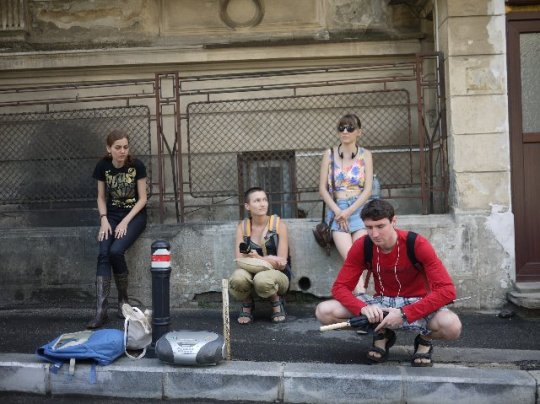
Maria Balabaș is known for her involvement in music and cultural projects in the Bucharest creative scene. She’s part of various experimental music and sound art project, with Avat'n'Gard, the improvised music collective, being the most notorious. Maria is also a very active journalist and has been doing her radio show, Dimineața Crossover at Radio România Cultural, since 2008.
Together with critic and contemporary art theoretician Daria Ghiu , they started the project Sunete care umblă (literally sounds that walk), a bold move that brought sound walking to Bucharest, with unexpected success. These walks, conceived by Daria and Maria, invite the audience to discover the city through its soundscape, within carefully curated routes. They also feature contributions from selected artists and musicians.
We had a talk with the two in order to learn more about this fascinating project.
Hello Daria and Maria! First off – why sound walk? How did this project begin?
M.B.: We have 5 years of sound walks already!
D.G.: Indeed, the project started in summer 2011.
M.B.: We began doing the walks without a plan in mind, first time at Street Delivery. At the time, we didn’t think we would continue, we thought we should see how it goes, how we’d feel… It was a very good experience, we had very positive feedback every time and it just went on from there: we do a walk, then someone invites us to another event and so forth. Everything happened quite organically.
The initial idea happened while I was at Ars Acustica Festival in Prague. One of the guests organized this sort of walk, which impressed me very much. When I went to talk to her and let her know how moving this had been for me, she told me “Maria, but you too could do this sort of walk yourself!”. This encouragement motivated me to start this project. Coming back to Bucharest, I got in touch with Daria and we started doing a little bit of research, trying to figure out how we could approach the subject from a theoretical point of view, what was the history of this sort of practice and what we could bring to the table.
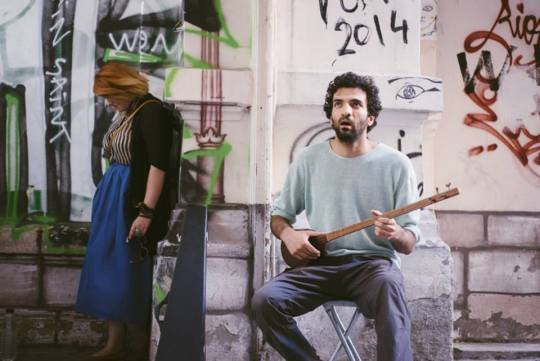
How did the two of you meet? Were you already friends/collaborators?
M.B.: I knew Daria already from the radio, since we were doing the Dimineața Crossover show together. We got closer once we started doing the walks, going on to do more and more things together over time.
D.G.: I’ve been doing a segment on contemporary art on Dimineața Crossover (Radio România Cultural) since 2009. Maria knew my interest in sound and radio art, since this was my field of choice.
The sound walks were something missing from Bucharest life, this type of guided tours focused on something other than sights, buildings or monuments. Besides this novelty factor, what attracted me to this type of walks is that they are closer to contemporary art shows and curatorial projects than to actual tours.
Daria, you have a background in contemporary art history and theory, while Maria is more of an artist/practitioner. How do you think this coming from two different worlds influences the way you work together?
M.B.: We did get much closer through the walks. For me it’s been a completely new experience – it’s very relaxing to be able to walk with somebody down the street and have a friendly conversation.
Daria, coming from the contemporary art world, balances out my enthusiastic, intuitive approach. I feel like my spontaneity works very well with her more cerebral take on things. It’s a very natural collaboration; I never felt any tension, any negativity coming from either of us. It’s always been a dialogue that is first expressed verbally at the beginning of the walk, continuing through silence for the rest of the journey.
Very interesting point! You two seem to be on the same page. And still, Sounds that Walk – who came up with the name?
D.G.: Why Maria, of course! She’s the real title master.
How were your first walks and experience? How did these evolve throughout the years?
M.B.: The walks always resulted in very strong reactions. Even after all his time, I still ask myself every time: “How will it go? Will I be able to hold the group? What kind of sensations will we experience this time? What is going to happen to us?”.
We started off from the idea of getting to know the city from a sonic perspective, since the visual aspect is so powerful that it remains our main view on the place. This sound approach has evolved into a form of poetics in itself: for each walk we choose a series of artistic moments. These can be interventions by fellow artists and musicians, or we try to shift the focus towards specific sounds or places.
In choosing our itineraries, I always try to build an emotional route, to capture a certain poetic sensation of the place.
In time, our involvement becomes more and more subtle, letting things happen by themselves. For example, at the first walk we did for Street Delivery, these moments were a bit too obvious: we entered a bakery and asked everyone to buy a 1 leu bread.
During our walks from the summer of 2015 at ArCuB, we thought things out differently, playing with our personal and emotional background more: trying to think in terms of what did these places mean to us, what childhood memories we could associate with them…
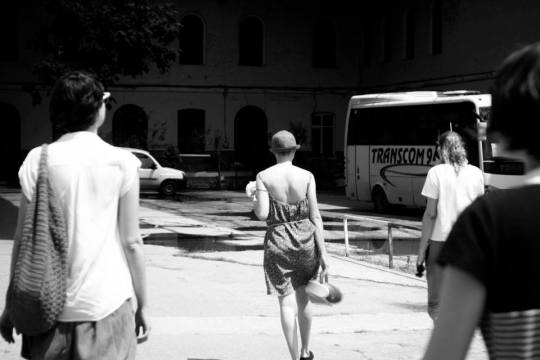
I would like to ask you about your process: how do you elaborate the walks? Do you visit places that have a special, emotional meaning for you or are you just looking for the sonic potential? Do you do location scouting together, for example?
M.B.: We always conceived the routes taking the given event and the area it was located as starting points. When we did Street Delivery, we worked with the area around Arthur Verona street and the Grădina Icoanei park, for the invitation at Femei pe Mătăsari (Women on Mătăsari street), the streets Mătăsari, Agricultori, when Raluca Voinea invited us at Tranzit.ro/Bucharest, we explored the cluster of streets and places around Carol Park, such as Gazelei street, the Filaret bus station, Patriarch’s Hill, for the WASP section during Xplore Dance Festival – the industrial area around Timpuri Noi...
Coming back to ArCuB, which recently moved in the Lipscani area, we elaborated the walk starting in the old town, reaching the Intercontinental hotel very intuitively, while being responsive to all the things we observed along the way: “Oh, what if we went that way? What if we took a right here?” and so on, discussing the sonic potential of each space we entered.
D.G.: We then focused on exploring this idea of the passageways of Bucharest, so present on Calea Victoriei, with Walter Benjamin in mind. Another very important aspect for this last project was having a production budget for the first time. This way, we were able to pay the artists we wanted to collaborate with, which made the entire experience feel more complete.
Sound walking is a practice initiated by R. Murray Shafer in ‘70s’ Canada, that has suffered many embodiments since: from artist Janet Cardiff’s Audio Walks, who introduced the narrative aspect and worked with binaural recordings, Francisco Lopez who did blindfolded walks, musician Christina Kubisch’s Electric Walks, using the sounds produced by electricity in the city, back to Hildegard Westerkamp, one of the first explorers of sound walking, who recorded her walks and turned them into radio art. How did you find the current format? What did you do in order make it your own?
M.B.: We chose to add our own interventions in the public space, as well as inviting other artists and musicians to join us.
We don’t particularly seek out to be personalizing the practice, but rather to offer a suggestion that would draw listeners closer to a certain type of experience. There are certain places in the city where your memory works differently and these sonic experiences also help in discovering the space around you. Also, especially in Romania, where the audience is not familiar with this kind of practice, these interventions offer some sort of in, an openness that leads to new dialogues.
Of course, there are plenty of unexpected things happening, coincidences that lead to very interesting situations that we later assume or incorporate in the future. During one of the walks at Timpuri Noi, when we reached a bridge, we offered people jam (a common Romanian hospitality custom n.a.) and we played a recording of Tiţa Bărbulescu, Ceauşescu’s favorite singer. For the same walk, we invited Miron Ghiu, Daria’s brother, to do a sound intervention on the same bridge. It was a rainy day and the water was flowing really hard, and the sounds that he made with a playstation, some circuit bending and other crazy stuff were perfectly in synch with the sound of the water, it was amazing! This showed us how the same space could generate a completely different atmosphere. Things during the walks happen organically, but, at the same time, there is a sort of complicity between us and the participants.
During another walk we entered an underground parking lot, the most banal and devoid of personality pne can imagine, then all of a sudden we got out in the hotel lobby of the Intercontinental. It was very surprising both for them and for us, each and every time we repeated the walk.
How do people react when you ask them to walk together in silence? How easily do they get to join the game and how do the sound/musical interventions facilitate this process?
M.B.: I believe that silence plays a crucial part. At the same, it doesn’t create a divide between the participants and the organizers; on the contrary, it brings them together. These practices could be really extreme abroad. In our case, thanks to the interventions, we found a way to draw the audience closer to us. Ultimately, you don’t have to go out of your way trying to be exclusivist and scare people away, but the other way around : to make them discover, to have them want to come back to those places, to seek out the sounds of their own cities, to be more attentive to the world around them.
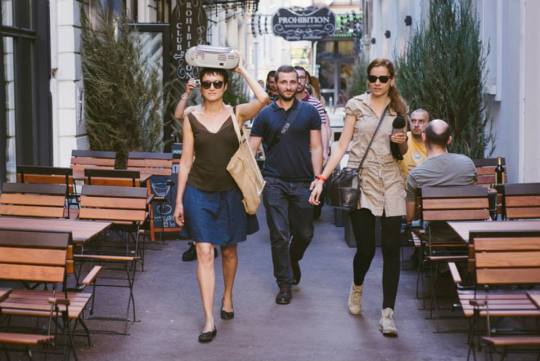
You already mentioned a couple of interventions, but I wanted to ask: what memorable projects could come to mind? What other artists did you collaborate with?
M.B.: We usually choose from a group of artist and musician friends, a very diverse bunch. During the walk at ArCuB, artist Daniel Djamo came up with a story about migration, a monolgue from one of his films that we played in the Vilacrosse passage. At WASP, there was someone playing tibetane bowls and we had Cătălin Milea from the band Timpuri Noi on saxophone. And on every tour we walk around with portable stereo…
…oh, some sort of Bucharest ghetto blasters?
M.B.: Ahaha, indeed!
Speaking of Bucharest, a place full of all sorts of extremes that a lot of people view as a hostile, noisy and polluted environment, what is your relationship with the city?
M.B.: I think that through these walks we managed to rediscover the city and get closer to it. It’s something very personal; you work with your emotional memory, you accept it as the place of your childhood and later you discover that you can work with it in many different ways.
I feel that it’s a place full of opportunities, with a lot of things still left to discover. I believe that we’re being fed this image of the city as a hostile environment and people are just being influenced and react to this rather than trusting their own sensations. We’re being aggressed by our own frustrations, focusing on what happens to us and our worries, projecting this onto the environment.
A sound engineer friend of mine recently came to visit Bucharest and told me it was one of the most calm capitals he’s been to.
What sort of feedback did you get from the participants after the walks?
M.B.: We had very surprising and positive reactions: the people involved were always quite amazed and had many unexpected reactions, describing a feeling of peace at the end.
The strongest feedback was during our ArCuB walk, where we had a lot of new and unknown participants that renewed our belief in the importance of this project. The thought of walks in silence could seem difficult, but if you accept it, the result is surprising. Many of them described the experience as a meditation.
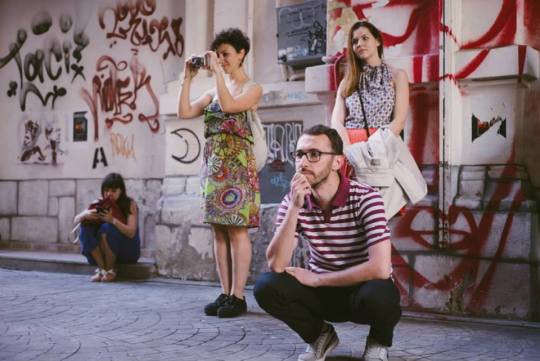
How do you choose the participants? What kind of people show up after an open call?
M.B.: We have a mix of friends and new people every time, but lately I’ve been pleasantly surprised to see more and more fresh faces. There is also a great deal of people who come back for other walks too!
From what I’m hearing the people who do the walks seem happy; but what is the reaction of the people you meet along the way? Have you ever had any unpleasant reactions?
M.B.: Yes. Once we were in the English passage and our friend Mehdi Aminian was playing the pan flute when the ladies upstairs threw a bucket of water over us! This has been our only major incident, people don’t really interact with us in general.
D.G.: Despite being in a public space, destined for circulation, people took some sort of ownership of this passage, seeing it as their courtyard that belongs to them entirely. I feel that this sort of publicat-private dynamic is very important for a city like Bucharest.
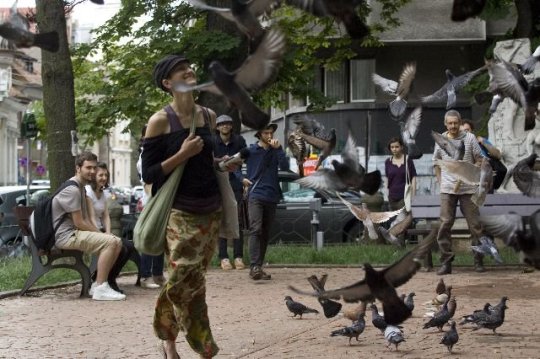
Disgruntled local housewives aside, I have the feeling that the interest for sound walks seems to manifest especially amongst women: Janet Cardiff, Hildegarde Westerkamp, Adrien Piper etc. Why do you think this happens, despite other sound fields dominated by men?
M.B.: I think it may have something to do with a sort of female empathy – we’re more intuitive, more careul in general. Women feel the need to work with the city and public space differently, less intrusively. It’s probably also a question of being meticulous, patient: through these walks and observations you have the feeling of cross-stitching the city.
You have already 5 years of doing the walks; what other projects do you have planned for the future?
M.B.: At this moment we’re preparing for a workshop during a film festival for people interested in working with sound differently. Then we’ll have to see what the city brings to us!
Thank you so much Daria and Maria! Any last thoughts?
M.B.+D.G.: Thank you Andra! We would also like to thank all photographers who accompanied us during our walks!
All photographs courtesy of Sunete care umbla. For more information and future walks visit their Facebook page.
0 notes
Text
Terekke - ( ͡° ͜ʖ ͡°)
for The Attic Magazine
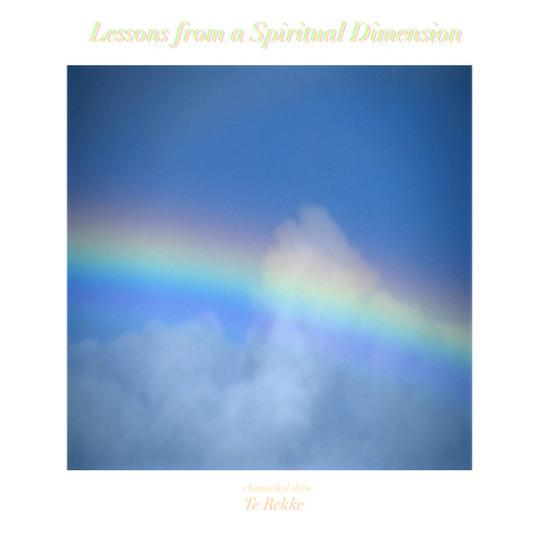
4.5 / 5
Label self-released
Released 2015
Published February 15, 2016
I can be extremely picky when it comes to ambient music. There needs to be a perfect balance between melody, noisiness and duration. And, most importantly, bedtime compatibility. The only other person I know that's even pickier than I am is my current boyfriend and I have to tell you, finding the one drone/ambient album that he likes has always been a challenge.
One evening during the hectic days of the Interval festival, while trying to squeeze in a disco nap between voluteering duties, he played this incredibly floaty, soothing cocktail of drifting clouds for me that sounded like pure liquid bliss. I was instantly blown away! So when I leaned over the screen to check out the name, I was extremely surprised to see the name of Terekke popping up.
I was familiar with his L.I.E.S. releases and hypnotic choice of cover art, but nothing within his techno really prepared me for this.
What is most appealing about this release is probably its uplifting quality in the use of synths without falling into the typical angelic sound usually associated with new age healing music. It is somewhat cold, but in a way the tip of your nose is cold on a sunny day after the first snow yet you feel all warm bundled up in your Wookie winter coat. I am tempted to say the three tracks feel like rolling waves. Not the ocean kind of waves, but rather a pulsating energy field that washes over you. It's the kind of feeling you get when you're stargazing at the beach, getting lost in the summer sky and slowly sinking deeper into the sand. Sometimes you might think you see a falling star in the corner of your eye, just for a quick second. Or maybe it was just an airplane. Or it passed by before you could really notice it and claim your wish. This is what ( ͡° ͜ʖ ͡°) really reminds me of - those magical nights in the Danube Delta when you feel like the sky is this compact block of stars that never really moves and somehow there are tiny micro events happening around you. A slight gush of wind, a spark from the nearby fire, the passing of a hungry hedgehog - little variations that would disrupt the perfect white noise of the sea. All set in a suspended parallel universe, floating in a white void. Because the modulations in the three tracks are quite minimal. It's as if Terekke had stumbled upon this magical frequency and all he wanted to do is to display it from every single angle, adding subtle textures or moving things around a bit, but trying to preserve this delicate glowing soap bubble for as long as possible. It's not like an Eliane Radigue piece where things sound the same but kind of evolve with time and by the end of an hour-long piece you're having this unexpected feeling of relief after a very constant micro build-up. Lessons From A Spiritual Dimension is a very quick drug. The trance-like state kicks in within the first few seconds and keeps you suspended in this sort of ethereal bliss for the next 30-odd minutes. The descent is quite sudden. It's probably more of a vision than a trip. While the title on the cover sounds incredibly appropriate (you would think he just went through a portal and made these tracks upon return), I prefer the Emoji. Along with generic file name titles, it has that sort of universal quality that strips away all the mystical connotations in order let the music do what it does best - make your entire body smile.
Tracklist:
1. Wav1 2. Wav2 3. Wav3
0 notes
Text
Golden Retriever – Golden Retriever
for The Attic Magazine

5 / 5
Label Root Strata
Released 2010
Published August 26, 2015
When I think of melodic drone music, the first thing that comes to mind is Golden Retriever. It’s one of those albums that I just keep going back to, regardless of my musical obsession at the moment. My bandmate Adrien recently said that drone music is musique qu’on ecoute quand on fait l’amour. I believe this record perfectly illustrates what a romantic French guy calls music for making love. Golden Retriever is perhaps one of the last great releases from the myriads of neo-drone new-age infused psychedelic music of 2005-2010ish. There was definitely a heavy revival of drone music, a so-called golden age of neo hippies that peaked around 2009. Between the synthesizer based experiments of projects such as Emeralds, Skaters, Dolphins into the Future, Ben Vida, the guitar drones and resonant frequencies of Grouper, Stefano Pilia or Aidan Baker to Dreamcolour, Heavy Eye of the Sun, Date Palms or Jooklo Duo incorporating unexpected instruments into the mix, the drone scene was thriving. While most of these groups are still active, I believe their style has shifted towards more abstract, EAI-based structures rather than hypnotic cosmic jams. Golden Retriever was one of those debut releases that instantly blew the Internet away. Based out of Portland Oregon, Matt Carlson on synthesizer and Jonathan Sielaff on bass clarinet have created a unique combination of organic melodies and out-there interstellar vibrations. The record sounds like a multi-faceted fractal ascent into hyperspace illuminated by the echoes of melting galaxies. False Entry, the opening title, probably has the catchiest phrase since Dragging A Dead Dear Up A Hill. It is a melody you actually get stuck in your head for days that keeps popping up every time you may think of this album. The entire album is constructed along hauntingly repetitive patterns, interwoven in a strange melodic dance. The way they evolve and build on each other creates a rich sonic soundscape, speckled with fragments of interjecting modular synthesis. What I find so extraordinary about this release is the delicate balance between composition and improvisation, leaning on repetition in manner tributary to free jazz rather than minimalist music. However, it manages to maintain the soothing qualities of new age while exploring the adventurous, dissonant side of the improvisational spectrum. Unlike my friends, I’m not a great fan of overly abstract, noisy experimental music. Golden Retriever finds that delicate balance between John Butcher fans, La Monte Young and people playing The Disintegration Loops on repeat, yet having an almost pop, uplifting quality. This is a really beautiful record, infused with a certain sense of wonder that somehow got muddled on their further releases. I can’t promise this might lead to any baby-making, but it will sure make for an interesting (imaginary) foreplay.
0 notes
Text
Yuka Ijichi - Peanuts Butter
for The Attic Magazine
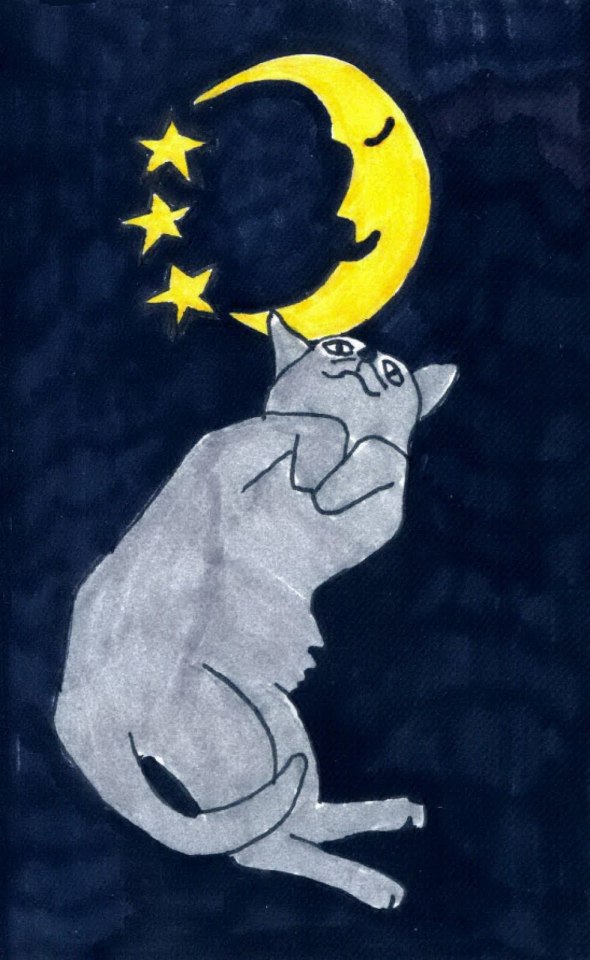
5 / 5
Label Sloow Tapes
Released 2010
Published September 15, 2015
A grey cat is lying on her back, paws up, floating through the autumn sky, towards the smiling new moon, accompanied by three lonely stars that frame her like a necklace, gazing towards infinity in a zero gravity midnight blue bliss. That describes what represents one of the most beautiful record sleeves I've come across so far, in all its naive, hand drawn glory. Yet those very lines might as well apply to the record itself, offering a rare instance of perfect synchronicity between artwork and music: they both reflect a sense of melancholic, bittersweet, childish sensitivity. It's been one of my favorite albums from the moment a good friend introduced me to it - and not just because of the sleeve, although I must confess it might have played a great role in my giving it a first listen. It is one of those albums you just listen from one end to the other, share it with all your friends and keep listening it for ages, till you know it by heart. Considering that Yuka Ijichi is a Japanese artist, it would be easy to fall into the simplistic kawaii interpretation - however, I think the tape manages to override the ''cutesy'' label. This is a rare, beautiful gem that sounds pretty much like nothing else while being strangely familiar - like finding an old photograph in the flea market of someone who vaguely resembles your grandmother. As far as psychedelic folk bands go, I did have a soft spot for all the improvisational Finnish artists such as Lau Nau, Kuupu or Avarus, not to mention all the American freak-folk scene of 2004-2008. But Yuka Ijichi is pretty much an artist that came out of nowhere, covered in the glowing aura only a pre-internet era bedroom musician could have, oozing of that overly emotional twee naiveté and lo fi aesthetics. In the Japanese context, probably the band I feel it closest to would be the Maher Shalal Hash Baz, especially for their underlying pop sensitivities. Maybe that's what makes Peanuts Butter particularly attractive - deep down, it is a very pop, melodic album in the most Brian Wilson sense of the word, while also incorporating psychedelic elements, a twee heart-on-sleeve sincerity all wrapped up in subtle, fuzzy analog tape hiss. Much of its psychedelic charm lies in the gorgeous spacy guitar twang provided by Kiyohiro Takada of the infamous 1960s' avant-garde band Les Rallizes Dénudés, another big influence on the record. Despite this guest underground star appearance, Yuka Ijichi displays a singular voice, certainly infused by those great heroes of the past, yet as someone who has internalized those influences and is ready to create something of their own. Peanuts Butter is a wonderful little treasure that stands out in the Sloow Tapes catalogue, an excellent Belgian label which rarely disappoints. So grab Mr. Snuggles, cozy up in your cocooning duvet and slowly drift into dreamland while watching your ceiling planetarium quietly fade away.
Tracklist:
A1. Ride Your Pony A2. Doo Dah A3. People Around Me A4. Hand Glass B1. Sunday Afternoon B2. Nawashiro Strawberry B3. A Sand Dune B4. Doo Dah (Closet Mix)
0 notes
Text
J D Emmanuel - Solid Dawn: Electronic Works 1979-1982
for The Attic Magazine
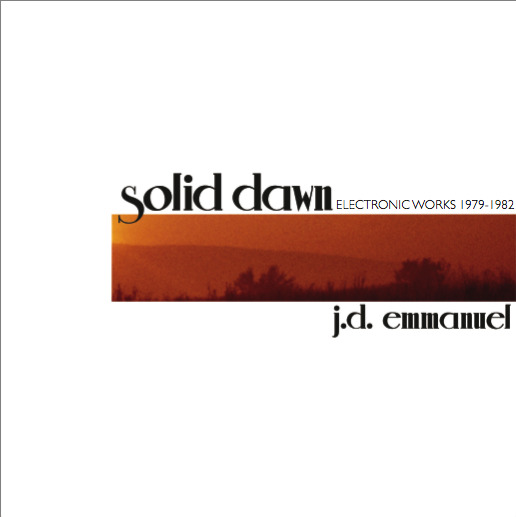
4.5 / 5
Label Kvist
Released 2009
Published August 11, 2015
I have to admit that, for the last month, I was not able to fall asleep to anything other than J.D. Emmanuel’s Solid Dawn. I first discovered Daniel’s music on the excellent I Am The Center compilation; this was one of those surprisingly cross over records that gets reviewed in The Wire magazine, but also one may read about it on both French Vice and Pitchfork. I also recently spotted it in the Rush Hour store. Despite the multiple listens, I only started looking for information on James Daniel before starting this review. There is no Wiki entry, but his website is pretty much a treat it itself - on his homepage you can see this photo of a guy wearing a cowboy hat in a Tony Bahamas shirt standing besides three keyboards. It looks like one of those ridiculous late ‘90s amateur musician websites where the artist strikes the “me and my instrument” pose, photographed by his mum/wife/bff. If you haven’t listened to his music previously, this may seem like a total turn off. However, upon further reading about this new-age guy from Texas who describes his music as ‘’electronic minimal’’ and cites Terry Riley, Steve Reich and free jazz among his influences, well, there’s someone you can’t really diss. His compositions are particularly strange and complex; unearthing this information about his process and musical background sheds a little light on exactly why they sound so unique and captivating. I still can’t get over his homepage description talking about spiritual awakening, conceiving music as a form of time travel and electronic meditation. This is probably the best part of the whole text and might explain its therapeutic qualities in curing my insomnia: ‘’My music is wonderful as background when working, reading or studying to help focus for better retention without getting too tired, as well as used for relaxation or during a massage to release tension better for deeper body work.’’However, I do believe this to be a gross understatement of his work, placing him among Arizona topaz-peddlers and other cheap ‘80s hippies. J.D. Emmanuel’s music transcends the logic of new age healing music and his compositions may comfortably sit along the works of the so-called respected minimalist composers he admires so much. Just like other forgotten hippies that resurfaced in the mid-2000s (Linda Perhacs comes to mind), Daniel’s story is one of the ‘mystery box in the thrift store’’ kind. Sure, labels have been using this “found flea market tape’’ strategy lately to the point of people seriously starting to wonder whether or not this is ‘’real shit from the 80s’’ or just a fabrication of nostalgic hipsters. Drew Daniel was questioning whether or not this need for authenticity is really important in our understanding of the music in a review of Lewis’ L'Amour; his argument was in favor of this fascinating area of suspended disbelief – ultimately, there’s a strange beauty in not knowing. In 2005, music journalist Douglas Mcgowan stumbled upon a couple of cases of dusty vinyl records in a library when he moved to Texas. They contained two of Emmanuel’s releases from the early ‘80s. As the story goes, this discovery leads to critically acclaimed reissues and even Daniel’s return to performing and recording in 2010. Although Echoes from Ancient Caves and Wizards are considered his best releases, I believe this compilation to be a good introduction to his work. It may have something to do with the fact that this is a collection of early, neglected, previously-unreleased tracks. Or maybe I do have a strange fascination for the marginal and overlooked. Or it probably just holds a special place in my mind due to my personal connection to it. Whichever it may be, this is a very beautiful collection of melodic drones that would appeal to both the noise fans and the electronic music aficionados dipping their toes into beat less music.
Tracklist:
1. Movement Into Lightspeed 2. Sunrise Over Galveston Bay 3. 7 Note Trance 4. Grandioso 5. Through The Inner Planes 6. March Of The Colossus 7. Whirlwind 8. Changeling
0 notes
Text
Beatrice Dillon - Blues Dances
for The Attic Magazine
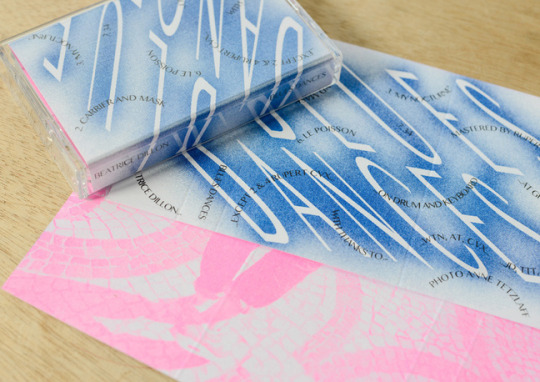
5 / 5
Label Where to Now?
Released 2014
Published December 17, 2014
When Dragos asked me to contribute to his new magazine, I was super flattered and excited and had a billion article ideas in mind. But as it often happens with manic enthusiastic people like me, there’s a pretty huge gap between our aspirations and actual achievements. So after a couple of missed deadlines and friendly reminders, I decided it was time to finally sit down and start writing.
I was dead set on reviewing my friend Adrien’s excellent Slot Machine Music Vol. 2 CD-R that just got an LP reissue mastered by Jason Lescalleet, but alas I got sidetracked by this other release and ultimately decided that if I were to write about something, I should probably start with an album I’m really passionate about. So, after reading this article in the latest issue of The Wire (and as many of my friends can vouch), I’ve been having quite a bit of a lady-crush on Beatrice Dillon. And by lady crush I mean not just ‘oh this lady is SO cool I like her music’, but more like a dozen of my friends waking up with an exclamation-mark ridden 3 AM email from me, sounding like the ultimate teenage fan girl saying shit like ‘OMG!! You guys!!! THIS!!! You have to listen to THIS!! NOOOOW!!!’ And I NEVER do that! Well, almost never. At least less in the past few years, since I started making money as a DJ. It’s a little sad when you catch yourself starting to get cautious about casual music sharing. But I digress. My first reaction when reading the article in the Wire was ‘ok, here is this probably 40-something nerdy artist lady from London who’s into world music, Gwen Guthrie, makes sound art pieces and is programming drum machines - if I were 14, I would say this is who I want to be when I grow up. Heck, even as a 26 year old sound artist/DJ I would still say the same thing!’. Honestly, I was super intrigued to hear this lady’s music; not so much because of the promise of alien techno stochastic non-club music, but mostly because her of her eclectic taste and contemporary composition background. While waiting to track down the release, I started reading a few of her interviews and the more I read, the more I felt like I could relate to her and her taste and ideas: the intellectual appreciation for dance music, the intuitive approach to composition and her general gender-bending musical curiosity. Sure, this might seem quite trivial for the millennial who grew up on post-everything productions, but for us grandpas raised with more conservative genre definitions, eclecticism is still considered an asset. So one sleepless morning, I finally gave Blues Dances a listen; my expectations were fairly high and yet I didn’t quite know what to expect. One thing was sure – I was hooked. Lately I’ve been mostly listening to just two extended families of music: drone and dance music. This tape was the mutant child of both worlds. At around noon when my friends started waking up and I had shared this with a fellow synth geek his first reaction was ‘Oh nooo, you ruined my life! This lady is doing the exact type of retarded bass type of thing I wanted to do! She already made all the music I wanted to make!’ Of course, this didn’t stop him from loving it too. Here’s the nitty gritty of the most exciting half hour I’ve heard lately, track by track. Longing, the opening track is based around a sample of an Ernst Jandl poem, coupled with a sparse yet vigorous bassline, vocal-improv specific mouth sounds and tiny field recordings textures. The album moves into a more rhythmic structure with Carrier and Mask, an outer-space muffled dub piece with a techno restless knee and one of the most elusive vocal hooks ever. Cue ‘My Nocturne’, a DADA dialogue between a celestial drone theme and a murky, giant 6 feet under bassline. Side A ends with Halfway, probably my favorite track from and the most playful from the release – at roughly 126 bpm, it might be the most club appropriate piece. There certainly is an invitation to movement sustained by a constant rhythm backbone; only the invading additional elements are so present that they completely transform the potential dance track into an underwater abysmal parade of strange creatures, with no beat drop in sight. It might be more appropriate to think of her pieces as compositions rather than proper track; their structure is closer to classic contemporary and improvisational music than that within the electronic/dance genre structure. Having said that, side B opener Reebs Dub sounds like a 4th-dimension future relic, but can easily fall between the cracks of beat-oriented music. This is probably what a cross between stoned-out Peaking Lights and Gyorgy Ligeti would sound like. Poisson is a furious yet poised series of delay and pitch variations that sound surprisingly elegant and complex, creating a vast sonic space, with plenty of full-fledged movements. There’s a pretty insane panning game going on there – you can almost see the air vibrate and follow its trajectory. The tape ends with 34, a beautiful deconstructed piano theme that reminded me of this Katie Paterson piece I saw during Nuit Blanche 2011. In Earth-Piano-Moon, she sent Beethoven’s Moonlight Sonata by Morse code from earth to the moon and copied the reflected result. This was then written into a new score, including the lost/distorted notes. Hearing this play on a mechanical piano in an empty theater at 5 am was quite mesmerizing. I have to admit I did try and play two of the tracks in a club. Twice. To my surprise, I didn’t get any angry stares (ok, maybe a few confused looks tho) or ‘change this bullshit’ requests. I actually did see this girl trying to move her legs to Halfway after Larry Heard’s Ice Castles. Regardless of my early nightclub trolling, I am super excited to hear her full-length release next. 2015 is just around the corner!
Tracklist:
Side A: 1. Longing 2. Carrier and Mask 3' My Nocturne' 4. Halfway Side B: 5. Reebs Dub 6. Poisson 7. 34
0 notes
Text
Schling ding ding dinggggg tttttttttttttttttttttttt – Maximalist Animism, a conversation with Charlemagne Palestine
Interview with Charlemagne Palestine for Arta magazine (print edition)
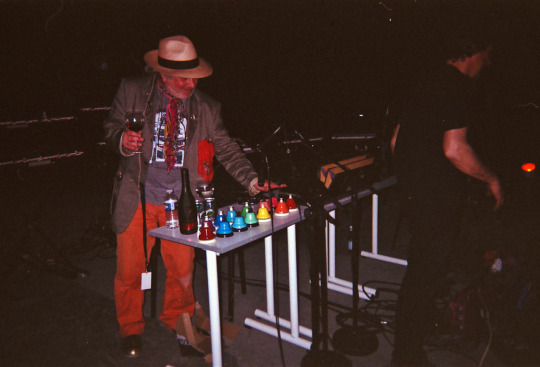
In recent years, the music world has been quite fond of throwing around words like “ritual” and “shaman”, be it for improvisational, psychedelic drone ensembles or Kanye West dressing like a wizard. Similarly, in the art world, mysticism has also been trending, if we were to take the Centre Pompidou rebooting its much-criticized show Magiciens de la Terrre, Fondation Cartier’s Vaudou’s expo or Quai Branly’s Tatoueurs, tatoués as an indicator.
However, if there was anybody who should deserve being called a shaman, that would be Charlemagne Palestine. At almost 70 year old, Charlemagne is one of those unclassifiable fringe artists who simply beam creativity: he’s that kooky character who always dresses very colorfully, wrapped in scarves and large fedoras, props which he describes as “identification symbols”, not just simple signature style elements. Charlemagne has probably met, collaborated with or pissed off anyone who’s anyone from the New York underground scene of the ‘60s and ‘70s. His biography is so dense and unusual, that it feels like a cross between contemporary art history and a Paul Auster novel: he started out singing in synagogues at age 12 to get out the Jewish ghetto, played drums for Allen Ginsgberg, scored films for Tony Conrad, taught at Cal Arts with Morton Subotnik and exhibited at Documenta 8, the Stedelijk Museum, Le Palais de Beaux Arts in Paris, the Venice Biennale. And the list is constantly growing.
His work ranges from building walls of stuffed animals to making drone music by placing bricks on church organs keyboards, while the title of his pieces read like Dada poems. Just take Schlingen Blängen, the title of his organ pieces, for example, or Gesammttkkunnstt MeshuggahhLaandtttt, the name of his latest exhibition, currently on display in Rotterdam.
Even during our correspondence, he peppers his lines with an excess of commas and exclamation marks, while elongating his ‘’t’’s, drawing out his ‘’n’’s and opening up his ‘’o’’s. He’s not just putting on an act though, but actually lives and breathes the eccentric mysticism of his pieces. Despite creating repetitive, trance-like pieces and having Terry Riley and Steve Reich as his contemporaries, he loathes the tag minimalis and claims to be part of his own current, which he calls maximalism, with a gust of baroque bravado. While music remains at the core of his practice, his interdisciplinary approach, incorporating installation, dance, film and video into his performances, has drawn him closer to the art world. The rising interest in sound art from museums and art galleries in the last decade has created a unique context where glitch video installations by Ryoji Ikeda, John Latham’s 16mm films, graphic David Tudor scores and Céleste Boursier-Mougenot’s installations with birds playing amplified guitars can coexist.
All my encounters with Charlemagne have been especially unique: I first saw him play in 2011 inside Anish Kapoor’s Monumenta sculpture at Grand Palais, a gigantic red blob entitled Leviathan. He had a set of colored doorbells and several organs, inviting the audience to join him in pressing the keys at one point. What intrigued me most about his setup was a large red suitcase filled with stuffed animals.
Three years later, during his opening at the Revoir Gallery, I would finally learn the mystery behind it: he explained how all of the toys exhibited, which stay behind as part of exhibitions are his friends, but the ones he carries around in the suitcase are family and travel with him everywhere. Also, they’re insured for 1 million dollars. However, his obsessive plush toy collecting has not just started on a whim, but is deeply rooted in his personal life and Jewish heritage, alongside influences from African animism and other non-western cultures.
In order to understand his complex work and personality, perhaps it would be better to go back to 1910, New York, when his family emigrated from Eastern Europe. His parents settled in Brooklyn, just a few blocks away from the Jewish couple who invented the teddy bear in 1902. To him, this geographical coincidence played a crucial role in the creation of his animal divinities. He also explains how in primitive cultures children are allowed to keep their toys their entire lives, since they have a sacred function and special relationship with the owner. Westerners take away the kids’ toys as a rite of passage into adulthood. His mother also did it to him, donating all his stuffed animals when he turned 11. As his animal altars got traction with the art world, he started calling his mum after every show to remind her about the incident and how he had been right all along.
While the creation of the teddy bear by a couple of Ashkenazi immigrants is the root of his divinities, another aspect of Jewish culture is at the core of his practice: the sacred music. Coming from a poor family, his parents were very determined to give him an education. He was a good singer and started performing from a young age, in synagogues and at bar-mitzvahs. The learning process of this type of music is very oral: there are no scores and everything is learned by listening and repeating.
This intuitive approach shaped the way he listens to and performs music, always seeking a sort of trance-like state. That is why his musical pieces stem directly from this concept of the ritual, using long notes or continuums, as he calls them, as well as very specific, totemic objects.
His relationship to sacred spaces goes even deeper, as he worked as a carillioner or bell-ringer in a church across the street from MOMA for almost 7 years, starting at age 16. As he was doing this daily, he started playing the bells in new ways, exploring their particular tonalities. He saw them more as a sound sculpture, an instrument with limitless possibilities. As the sound of the bells could be heard from the sculpture garden of the museum, this gig earned him a reputation in the art world, with people such as Moondog, Tony Conrad or the president of TV network CBS among his fans.
And this story is just the tip of the iceberg for the expansive personality of Charlemagne Palestine. He was kind enough to answer a couple of our (many) questions via e-mail, before his show in Bucharest for Saptamana Sunetului (Sound Week).
Charlemagne, your career is beyond impressive from your training with Pandit Pran Nath to film collaborations with Len Lye, every chapter seems like a page of modern musical history. You were active in the extremely effervescent experimental scene of New York in the 70s, where the collaborations between musicians, artists and filmmakers were a flourish, with musicians like Angus MacLise contributing to the score of the seminal The Invasion of Thunderbolt Pagoda, for example. at the same time people like Etienne O’leary and Phil Niblock were both making movies and making the soundtrack. I was curious to know what has drawn you to movie making, installation and performance art - how did you get to your “maximalism”?
Charlemagne Palestine: Actually in my case it was video making, multi-media installations (that’s the word we used a lot then, multi-media) and performance art, then also sculpture, some drawings and a bit of painting, even a bit of photography and eventually a few films too.
But the problem was always that these terms separate these languages of expressions into different zones, even video and film are different zones.
These last almost 50 years I’ve just “done” things: wherever, however, whatever. It seems that with that approach (and I was just another member of a whole generation that began working like that) we opened the floodgates to the “everythingzz".
We were a visionary generation, because now, with a laptop, young creators can do everything, anything in all forms and styles, with a few gadgets and their computers, they are doing that. But for us way back then it was very hard and cumbersome to do anything “multi”. Now there are courses all over the world about all these forms but back then there was a lot of sabotage and skepticism in the main stream against artist creators like us!
My first works were more austere. That was the New York style at the time, though even my austere works were not as austere as many of my colleagues’. Early on I had my animal divinities and many didn’t like them, understand them, permit them, present them…Soooo already I was often excluded by the “boysz club” and as I’m a boy anyway, excluded from the girls feminist club too. I was floating, blown back and forth from one camp to another, almost always an outsider.
Over time my works began to get more colorful and fanciful and weirdyful and unclassifyiful… People have been so annoyingly obsessed with this “minimal” word, a term that I hate. For me the word means someone who leaves a small tip at a restaurant, someone who’s “cheap”… But the word is like an infectious disease and has been for 50 years. Maximal is so much more open and airy and has so much more potential! No limit!!!
So certainly I got bored with minimal and gradually became more and more maximal, but I suffered for that many in the artyclubsz. I didn’t like that! Sometimes I felt I could do no “right”, but now, at almost 70 years old, fuckemmm…Although now some think I did a lot “right”.
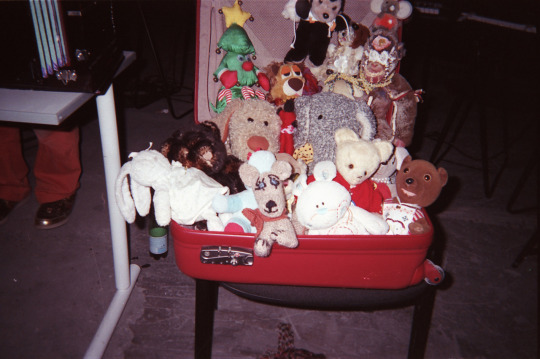
It seems to have been a very challenging path for you. Even now I think people are separating themselves and others into very specific groups, even within one domain like improvised music, for example. What kept you going over the years, despite all the obstacles?
C P : Early on, being an artist was my dream, my mission. Now the word artist means more a slick business strategist and I often try to avoid the term “artist” about myself!
So I just did what I did, do what I do and now it’s more okay. Even some of my old enemies begin to respect me and the new younger generations are being very generous with me. Some people even say they’ve all been inspired by me!
Indeed, you are quite the role model for a lot of younger fans. Speaking of labels and support, I would like to move on to my next question - - you seem to have had more and more invitations from museums and art galleries to present your work. Experimental film and music have always been a very marginal domain, struggling to find a place between the film, music and art world. What do you think about this renewed interest in sound art, experimental music and 16mm film coming from art institutions? Does this mean that the underground has finally been accepted, being given the museum's seal of approval?
C P : There are now many, many art institutions all over the world, many more than when I started 50ish years ago. Some of them are well funded, many more of them have lesser funding. There are thousands of galleries now and when I started there were hundreds, so that does provide a lot more possibilities for all kinds of mediums.
Nowadays people want to experience more than just painting and sculpture, now installations, all medias, video, film, photography, hodgepodge…everything all together!
Experimental sounds and musics also provide the possibilities to present whole big shows, but for not enormous amounts of monies to organize them!
Unfortunately it’s still very though unless one is member of the art world elite, commanding big bucks for their works. These venues that now bring a lot from the underground to the aboveground and many artists who were “between the cracks” before, now get to have higher public profile. The little known pioneers and their followings, many have already departed on the “other side”. The ones still with us still suffer from limited financial support systems, so there are many multi-million dollars/Euros even billion budget art centers and museums.
Many of them provide hundreds or thousands of dollar/Euros budgets for media arts and they’ll spend millions on what they see as blue chip elite new plastic arts, but only hundreds or thousands on media arts from the same generation. So the aboveground artists who used to be underground are still only paid…underground wages!
And let’s not forget that once there were hundreds maybe a thousand or several thousand artists back when I started and now there are hundreds of thousands, so the math is still lacking enough bucks to seriously subsidize any more than a very small percentage of our artists today.
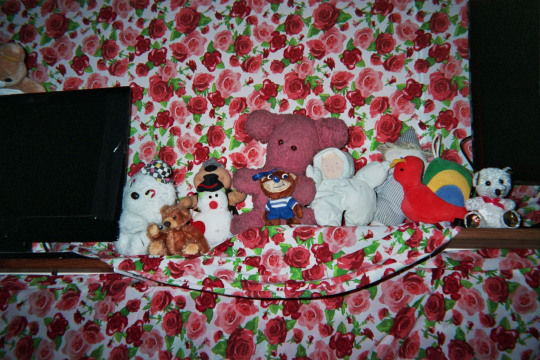
Indeed, the museum system is far from being merit-based. If anything, it’s gotten more business-like over the years. Going back to filmmaking, you can´t mention experimental film without the name of Revoir founder Pip Chodorov popping up. When did you first meet? How did your friendship begin?
C P : I met Pip Chodorov in Paris through a mutual friend from Holland who brought out my CD’s in the nineties. Although Pip and I are both New Yorkers, since we are from different generations I didn’t meet him in NYC but in Europe. He has done several films about/with me over the years. I’ve had a video retrospective show two years ago at his Revoir gallery in Paris!
Last year for the Sonic Protest festival at the Eglise Saint Merry, you presented a new collaborative project with the young musician Mondkopf, who comes from a very different background, being a techno DJ and producer. At the same time, recently more and more techno producers are drawing inspiration from drone and minimalism, sometimes integrating it into their sets. How did the collaboration begin and what do you think about the rising interest in experimental club music?
C P : I’m interested in collaborating with all the different generations and approaches, whenever I can!

The piano and organ play a central part in your practice. These instruments have such a rich and revered history that has also been challenged greatly, starting with John Cage and the prepared piano. You always perform your own pieces, but I remember during the Anish Kapoor show at Grand Palais in 2011 you invited audience members to participate and touch the keys/keep the drones as well. How do you continue to constantly challenge and integrate the improvisation and performative elements into your music?
C P : I am always trying to find unexpected, new ways to use the “present” differently. I don’t like the word improvisation: it’s overused and means almost anything and everything. Improvisation is too vague for me, not strict enough. I prefer ”in the moment” as a term, in the now.
This is going to be your first performance in Bucharest, a fascinating city full of contradictions and the home town of spectralist composers Iancu Dumitrescu, Octavian Nemescu and Horatiu Radulescu. Have you prepared anything special for the occasion?
C P : As all organs are different and unique I will do a Schlingen Blängen (name of my organ pieces since the 70’s), especially for the organ of the Bucharest Music Conservatory and its specific acoustic!
Speaking of organs – there was a church that collapsed recently and crushed an organ in Transylvania. In Bucharest you will be playing the exact type of organ as the one that got destroyed. Would this story be integrated in/influence your performance in any way?
C P : Not sure but maybe. I’ll have to see how it feels “in the moment”!
One last question: speaking of Romanian Artists, some very interesting and radical acts have merged from our experimental music and art scene, despite it being still very small. Irinel Anghel is one of the most eccentric forces in this milieu. She recently stated that she would like her funeral to be turned into a big party, with fireworks taking off from her body and music and drinking and dancing. She would count this as her last piece of performance art. I thought the sheer crazy exuberance of this idea might have a certain affinity with your work. In the same spirit, how would you plan your funeral party?
C P : I have looked at Irinel’s works on the internet and it is full of dynamic expression, which I like. I too have been thinking about how I’d like to be preserved when I die, but I’m 68 years old and Irinel is only in her forties. But of course if any of us die today…We are the oldest of our friends, to say goodbye so soon…fireworks during her funeral…sure! And music and drinking and dancing. But why not do that while alive to? Robert Filliou the French conceptual Fluxus artist made a calendar where every day of the year was a Holiday! So one could have 365 holidays a year with Fireworks and Dancing and Music, die and be reborn…everyday!
Thank you so much Charlemagne, we’re looking forward to your show!
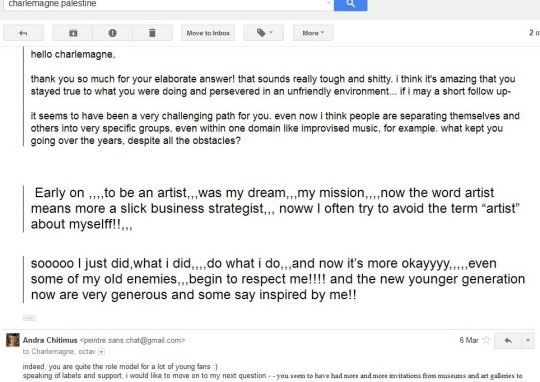
Charlemagne Palestine is playing in Bucharest on March 20th, 7 PM at the George Enescu Conservatory for Saptamana Sunetului (Sound Week).
images, in order of appearance
01. charlemagne performing in Anish Kapoo's Leviathan at the Grand Palais in 2011
02. charlemagne's "family" animals in the red suitcase, Grand Palais
03. installation view from the revoir show, 2014
04. charlemagne with pip chodorov at the opening of his show at revoir gallery, 2014
05. correspondance screenshot
All images courtesy of feral n0is3
0 notes
Text
Fourth World Magazine Vol II - Pinhead in Fantasia
RH Distribution
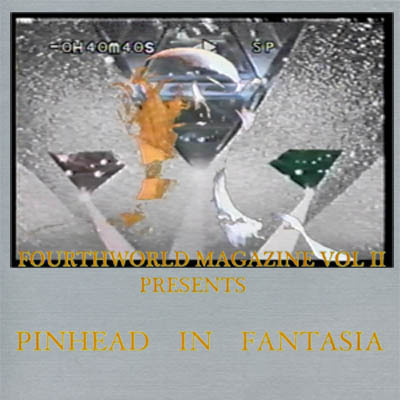
Esoteric synths and classical harmonies from The Skaters mastermind. Pinheads in Fantasia is probably Spencer Clark's most out-there endeavor. At some point his records became more than just trippy music with crazy artwork and his use of symbols and poetry started to take a more central part in the releases. He even stopped calling them albums, preferring the term soundvisions instead. Fourth World Magazine Vol. II is the culmination of these tendencies, sounding like the creation myth for a new cult founded by Julio Cortazar, L.Ron Hubbard and Philip K. Dick in the garden of Locus Solus. And I'm not exaggerating with this. With the help of The Wire writer David Keenan and artist AR Faust, Spencer Clark has developed a multi-layered release, using accompanying video (or facehugging), text and a full-color magazine in order to create a more tangible artifact. Again, we see the lines between fact and fiction blurring greatly, making Pinheads in Fantasia a pure work of primitive science-fiction. First off, the album was supposedly “recorded in an Open Air theater and in a golden metal box simultaneously” . The title combines the character Pinhead, from the Hellraiser series with Walt Disney's 1940s movie Fantasia, with music composed and conducted by Leopold Stokowski. Clark also suggests that the conductor's death around his birth has somehow affected his spirit, turning him into a vessel for the defunct spirit or a cenobite, an explorer. This album is like a puzzle-box that unlocks the door to other dimensions, giving Clark access into the listener's realm. And all this just to give you just a taste of his new mythology. The music is a strange mix of micro-tonal melodies, warped alien vocals, gore sound effects, ritualistic percussion and Claude Debussy, following the pleasure and pain motif of the Hellraiser series, inducing a deep, trance-like state. An utterly impressive, cinematic work.
#Fourth World Magazine Vol II#rush hour distribution#Pinhead in Fantasia#spencer clark#reviews#drone#experimental
2 notes
·
View notes